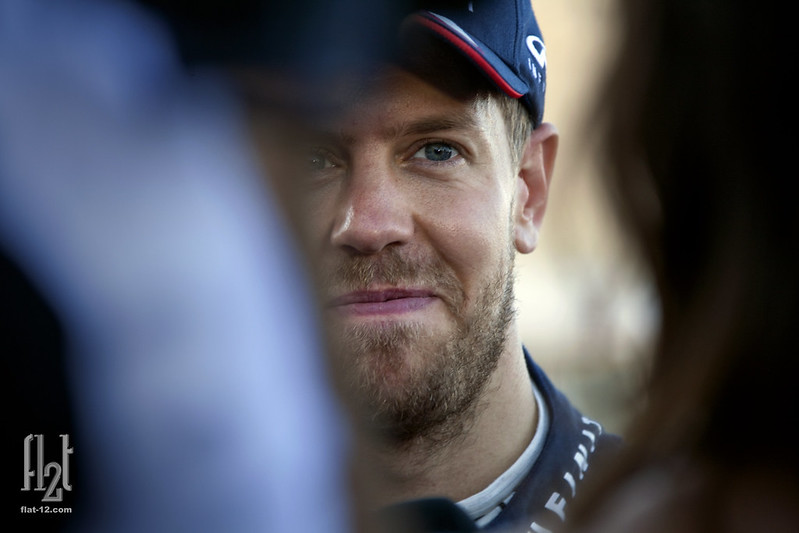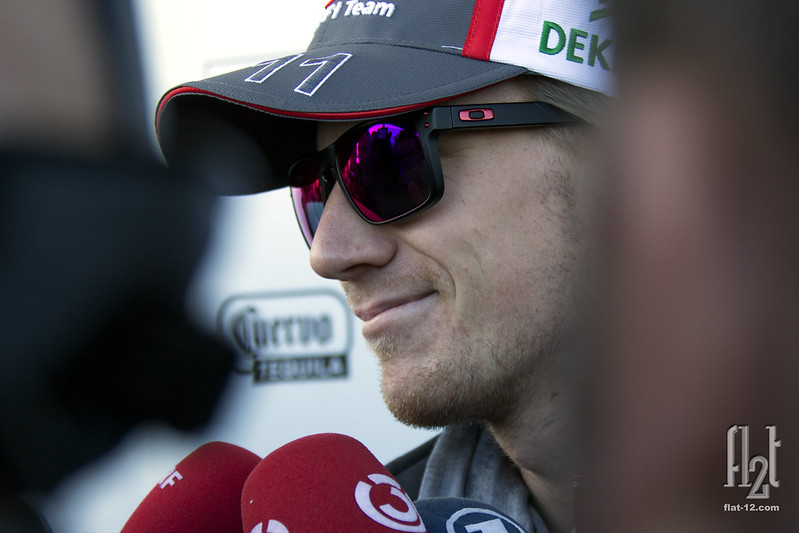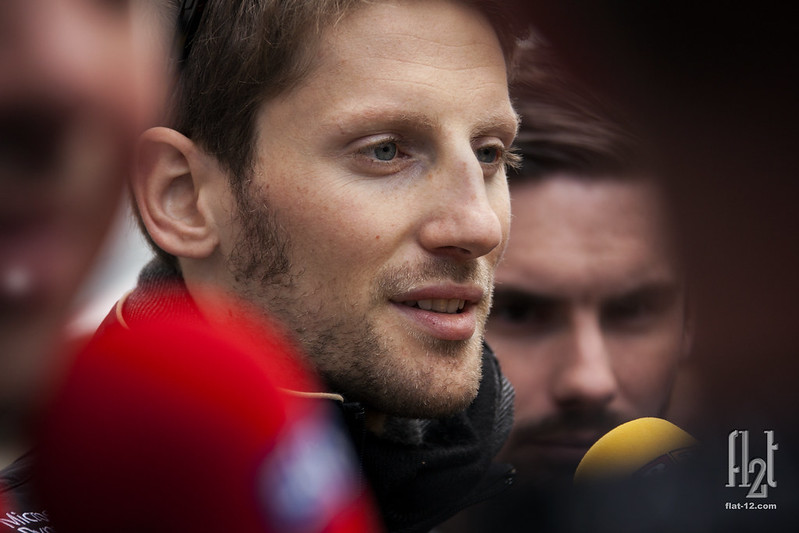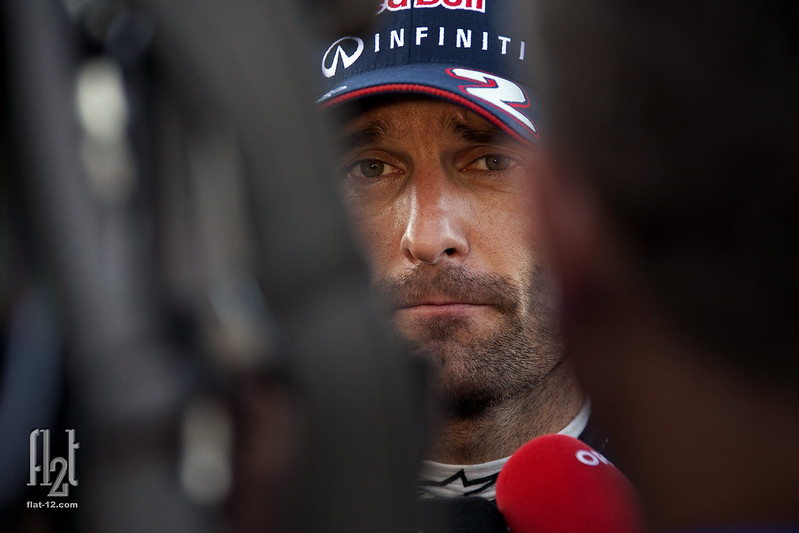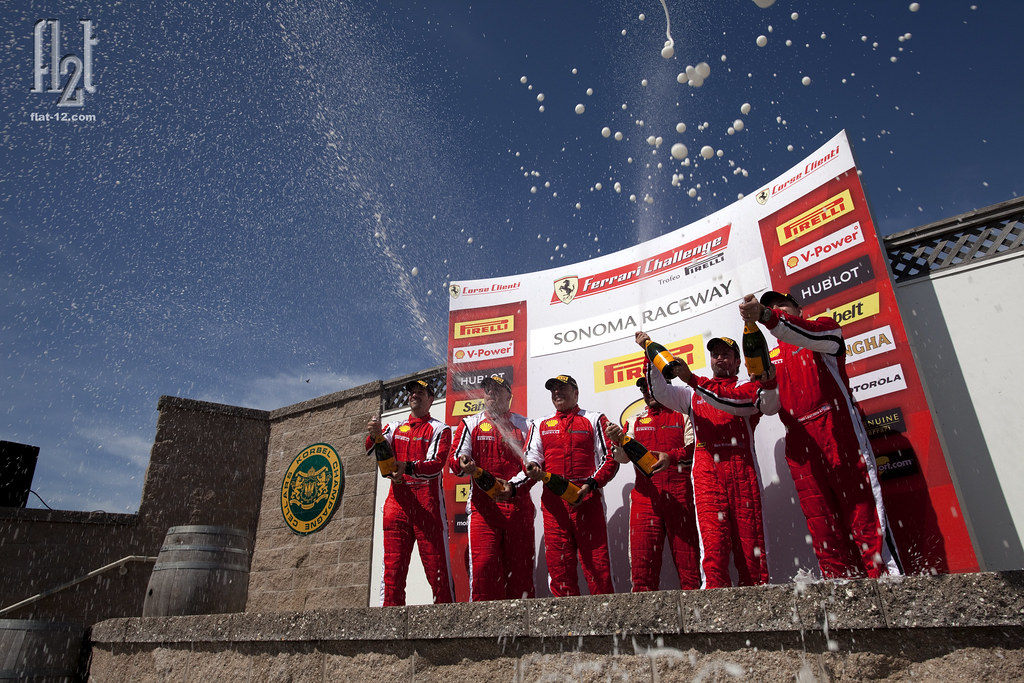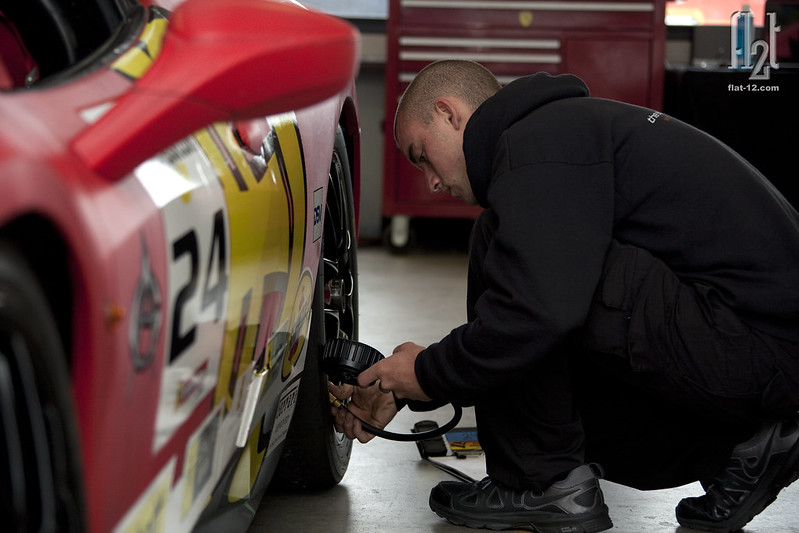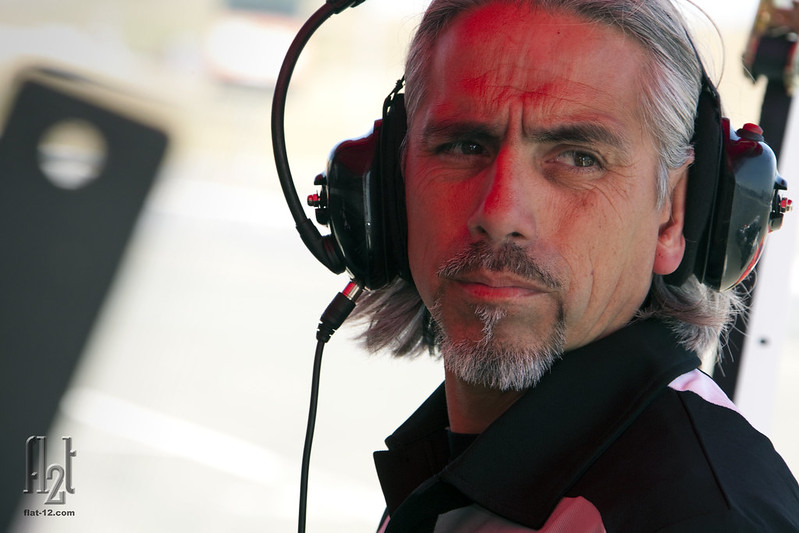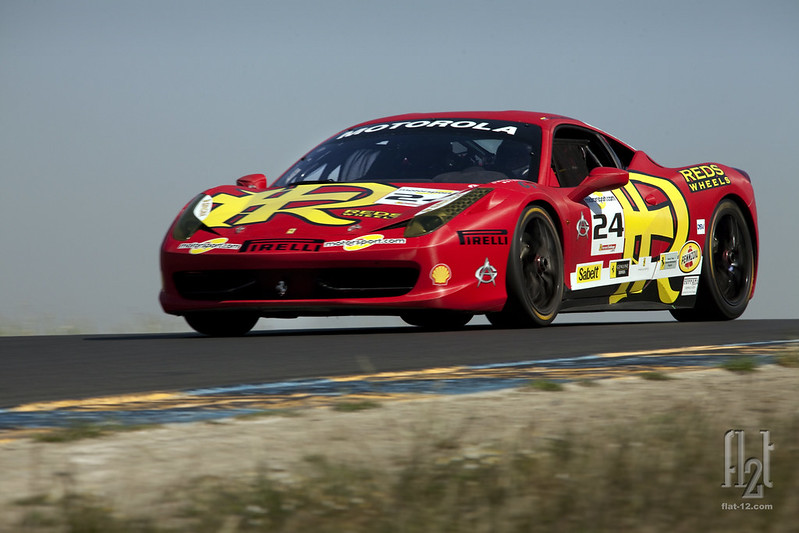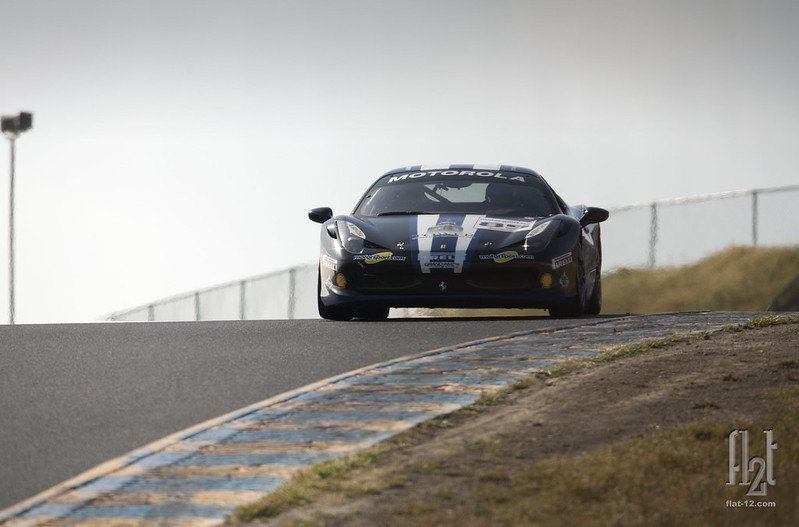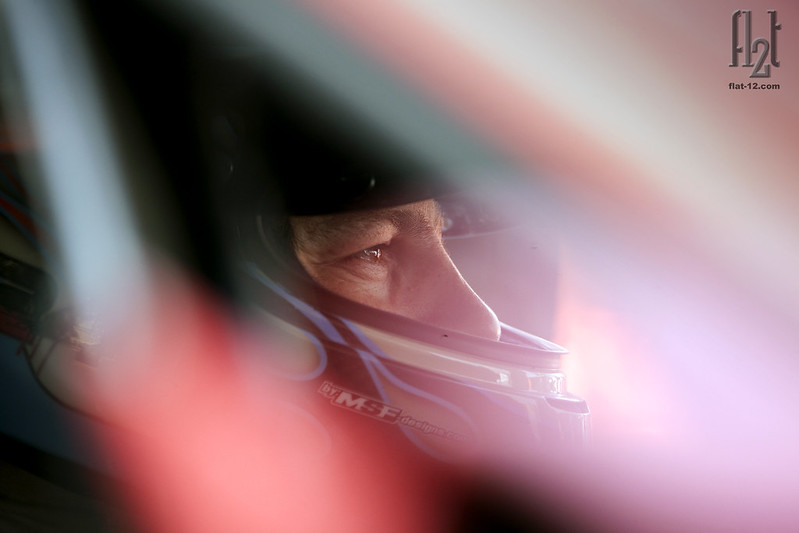Dear Reader:
Please jump over to my new website, and new blog . . .
http://flat-12.com/
Thanks for following Flat-12
Jim Hunter
Wednesday, July 23, 2014
Tuesday, January 28, 2014
Top Ten c2013
With the start of 2014 pre-season testing, here's the Flat-12 Top Ten for the 2013 F1 World Championship and some thoughts on the year ahead. Better late than never?
2013 was a difficult year for F1. Pirelli, acting on direction from the sport, delivered compounds so delicate that drivers were left skittering for grip and engineers scratching their heads. Purists cried that F1 had become artificial and drivers lamented that their focus was no longer strictly on racing.
Yet for ten rounds this was the 2013 face of F1, where results were far from certain, everyone struggled equally, and tire discontent amounted to little more than grumbling and griping. That is, until Silverstone. High cornering speeds and sharp curbs combined to create an altogether separate and dangerous problem of de-laminating rubber and shredding carcasses. Not good.
Red Bull's determined lobbyist capitalized on the debacle to wrap the safety question around compounds as well as tire construction, and convinced the paddock that the time to return to conservative compounds had arrived. Thus, whatever unpredictability the 2013 World Championship offered was lost, and F1 once again returned to the temple of aerodynamics under the lofty reign of the deity of wind slip.
Politics have always played a role in F1, yet despite a string of exciting seasons where sport trumped scheming, they again rose to the fore in 2013. Ultimately, the abrupt shift was less about safety than it was aero supremacy. In this writer's opinion, this past season will go down as a triumph of politics over sport, and one of the poorest competitions over F1's long history.
As the season unraveled, I suspected that the task of drawing a precise perspective on driver performance would be tough. The thought of musing a brave fight to the podium or unexpected rise of a midfield competitor fell pointless and victim to my cynical nature. My normal sense of intrigue was virtually destroyed under the weight of fickle motor sport governance.
IMHO, there was a new chink in the sport's armor, and the latter half of the season felt like packaged entertainment.
In this light, is it possible to fairly evaluate one driver against his opponent? When does uncharacteristic mistakes, dysfunction, and intra-team fighting render the exercise futile? Ferrari, Lotus, McLaren, Sauber, Williams: each endured tension and strained driver relationships at some aspect of the campaign.
F1 drivers have often been, to some degree, portrayed as super human. Michael Schumacher set the example for what a human can achieve through commitment, determination, dedication. Intense training, conditioning, while adhering to very strict diets is just the beginning and beyond the discipline of most mortal men.
But as aero took precedence, F1 began to look more like a mortal endeavor. I guess F1 drivers are human beings who stumble through turmoil just like the rest of us, perhaps not as awkwardly, but stumble all the same. Sometimes at an additional 2.5 seconds per lap.
Therefore, I'm not certain the 2013 season is even worth discussing, but please comment if inspired. A little debate as winter testing commences might liven what will hopefully be the beginning of a more competitive era.
I did not go back and recount stats, compare lap times. My logic is seat of the pants and probably flawed. This is merely an impression, my impression, indelibly engraved in my mind by this horribly disappointing season.
1) Sebastian Vettel (ranked #4 in 2012, co-#1 in 2011)
Nothing sensational. Vettel's robotic pole to top step precision every week put me to sleep. He deserves, however, credit for bullet proof consistency, his almost complete lack of mistakes, and his making the most of the opportunity bestowed upon him. Vettel is quick, focused. He's managed to place himself in a position to win and at the end of the day that is often the most important skill of any competitor. I have always considered him one of the best, but despite his dominance I still don't rate him the most complete driver on the grid.
If Red Bull have one strength, they appear more adept at developing their car over the course of a season. Looking over the past five years, Newey's cars have never started as dominant as they finished. It would be fair to suggest that Seb is also an integral part of that evolution.
2) Nico Hulkenberg (ranked #5 in 2012)
Nico drove with purpose in 2013. The man definitely had something to prove, and he did just that. Yet despite proving that he is ready to fight at the front, Hulkenberg found himself victim to shoddy economics and had to resort to yet another midfield contender for 2014.
In time, I hope we'll see him at Ferrari. IMHO he's been groomed for that role long enough.
3) Kimi Räikkönen (ranked #2 in 2012)
Who'd a thunk Kimi's dominant win in the Melbourne season opener would prove to be his only victory of the season? Perhaps Räikkönen deserves better than this third place ranking . . . he should be commended for not allowing a lack of proper payment deter his early to mid season efforts: several brave and sensational drives from a man reborn to his prior mid 2008 form.
Unfortunately, as the season wore on things must've been disintegrating in the Lotus camp as Kimi appeared to lose steam by the time the teams reached Korea. Once Räikkönen was publicly dressed down by Alan Permane in India, it was over. Kimi showed up in Abu Dhabi despite reports that he had already given up, but his uncharacteristic first corner retirement gave pause to conspiracy theorists across the globe. No one was surprised when it was shortly announced that he'd driven his last race for Lotus.
4) Fernando Alonso (ranked #1 in 2012, co-#1 in 2011)
Those who know me will be shocked to find my relegating Fernando to a meager fourth on this tally. I largely consider Alonso the most complete driver on the grid and perhaps the world. Unfortunately, as it became apparent that Red Bull was once again gaining the upper hand, Fernando's human side reared itself in the form of frustration. After three and one third seasons prior where he drove with as much heart, courage, and stamina as we've ever witnessed, to come so close to taking the title in 2010 and 2012, it seemed impossible that he would remain invincible. To his credit he still managed a string of 2nd place finishes from Belgium to Singapore, so it would be unfair to suggest that he simply gave up.
I had a hard time choosing between Kimi and Fernando. The argument for rating Fernando higher is strong. Both drivers endured a lot of frustration with no real manner, but their phenomenal skills, to rise above. In the end I feel Fernando appeared a bit worn for wear, whereas Räikkönen simply opted to depart. Alonso may have also engaged his employer in a game of false posturing and media innuendo over a fictitious move to Red Bull.
5) Nico Rosberg (ranked #8 in 2012, #3 in 2011)
As I eluded to last year, Nico Rosberg is one tough nut to categorize, compartmentalize, or truly understand. Often identified as the most inconsistent driver on the grid, I find the description a tad unfair. Nico delivered three pole positions and two victories in 2013. Not counting anything but the top step, that makes him the second most accomplished pilot for the year (Alonso: two wins but no poles, and Hamilton: five poles but only one race win). Rosberg's Monaco victory was without doubt one the most determined drives of the season.
To date Nico has more than held his own over Lewis Hamilton, much as he did over Michael Schumacher. I'm guessing Nico may have trouble unlocking proper set up on occasion, thus adversely effecting his pace. He is certainly the most under rated driver in F1.
6) Romain Grosjean
One of the brighter aspects of 2013 was the re-introduction of Romain Grosjean . . . the Romain Grosjean that many of us suspected was there all along. I first witnessed Grosjean's pace in GP2 at Spa in 2008 on the high speed blast through Pouhon. I'm sure many will question my rating him above Hamilton, but I was extremely impressed by the manner in which Grosjean came alive in the mid season. Although Räikkönen may have at times been off form, Grosjean's ability to "pressurize" his teammate was very real.
7) Lewis Hamilton (ranked #3 in 2012, #6 in 2011)
I really wanted to rate Lewis higher. He fared much better than many who questioned his jump from McLaren had expected. He had five pole positions and at times looked to net more than his single victory in Hungary. I give Hamilton high marks for continuing to mature and for his positive working relationship with teammate Rosberg.
As he often found himself going backwards once the lights went out, I can only wonder whether inner struggles still distract his eye from the prize. Hopefully the 2014 title will be more clearly visible through his visor.
8) Daniel Ricciardo
I don't believe that he's Hulkenberg-ready for the front row, but Ricciardo has demonstrated himself capable of competing there. It's fair to say that he will only get better as 2014 progresses.
9) Valtteri Bottas
What can I say? I like this guy. Impressive, in Montreal especially. Given my respect for Hakkinen and Räikkönen, perhaps I'm partial to Finnish drivers.
10) Mark Webber (ranked #10 in 2012, #5 in 2011)
I really like Mark but struggled to find a home for him on this list. It's hard to know what to think about his time at Red Bull, only to say that I wish he'd gotten out from under there before retiring. Given the bizarre climate, I should credit Mark for managing results when other drivers such as Fernando might have blown a fuse.
Webber's race starts were consistently shaky, often nullifying whatever advantage he reaped from qualifying. I often joked that he needed to stop doing pre-race interviews on the grid as he appeared too focused on his post retirement broadcast career. Between the poor starts and sometimes questionable race judgement, Mark Webber will always remain an enigma to me.
I hold the cynical opinion that Mark's race car was at times treated by the team as a test mule, effectively providing Red Bull a test restriction work around. With Vettel on top every weekend and everyone else bumbling along behind, it would be interesting to do the math and determine how many of Mark's points they needed to secure the Constructor's title.
Webber will be missed. He once demonstrated the pace to be a potential world champion, but I never personally saw that happening at Red Bull.
In closing . . .
No doubt there are a couple of key names missing from my tally. Again, my logic can be challenged.
Jenson Button:
Jenson had a down season. The McLaren was a wash and he spent the first half of the year trying to avoid being run off the road by his over aggressive teammate. Despite my immense respect for Jenson I've often suspected that he really needs a car to his liking. He will be back at the front soon, I am certain. I truly believe the new era bodes well for Jenson as lessor drivers will struggle with torque and putting the power down effectively.
Felipe Massa:
Felipe finished 2012 on the upswing and I fully expected that trend to continue into 2013. It didn't. Ferrari were once again a one horse cavalry. . . and then there was Germany. Unfortunately for Felipe, Ferrari were left with no choice but to replace him. I wish him a successful rebirth at Williams.
The year ahead? My fear is that Vettel will run away with all 19 victories. That will make people forget about the funny looking noses, real quick. I now fully understand why I temporarily loathed Michael Schumacher when he won the first Grand Prix I attended; Imola '04. The RB-10 looks to pick up where its predecessors left off.
If we are lucky, Mercedes and Ferrari will rise to the fight and their potential. They possess the best driver pairings in the business.
Ferrari must deliver a competitive car and more importantly develop it throughout the season. The arrival of James Allison may ultimately answer Ferrari's life long struggle with tires, and that is huge, but the Scuderia's real challenge may lie beyond the wind tunnel. Did a lack of managerial prowess handicap the once promising F-138 from being developed to it's full potential?
Given the likelihood we'll witness greater transition in development this season as the teams grapple with the new hybrid turbo era, I sadly expect Red Bull to once again remain on top.
2013 was a difficult year for F1. Pirelli, acting on direction from the sport, delivered compounds so delicate that drivers were left skittering for grip and engineers scratching their heads. Purists cried that F1 had become artificial and drivers lamented that their focus was no longer strictly on racing.
Yet for ten rounds this was the 2013 face of F1, where results were far from certain, everyone struggled equally, and tire discontent amounted to little more than grumbling and griping. That is, until Silverstone. High cornering speeds and sharp curbs combined to create an altogether separate and dangerous problem of de-laminating rubber and shredding carcasses. Not good.
 |
| Rubber makes the politics go 'round |
Politics have always played a role in F1, yet despite a string of exciting seasons where sport trumped scheming, they again rose to the fore in 2013. Ultimately, the abrupt shift was less about safety than it was aero supremacy. In this writer's opinion, this past season will go down as a triumph of politics over sport, and one of the poorest competitions over F1's long history.
As the season unraveled, I suspected that the task of drawing a precise perspective on driver performance would be tough. The thought of musing a brave fight to the podium or unexpected rise of a midfield competitor fell pointless and victim to my cynical nature. My normal sense of intrigue was virtually destroyed under the weight of fickle motor sport governance.
IMHO, there was a new chink in the sport's armor, and the latter half of the season felt like packaged entertainment.
In this light, is it possible to fairly evaluate one driver against his opponent? When does uncharacteristic mistakes, dysfunction, and intra-team fighting render the exercise futile? Ferrari, Lotus, McLaren, Sauber, Williams: each endured tension and strained driver relationships at some aspect of the campaign.
F1 drivers have often been, to some degree, portrayed as super human. Michael Schumacher set the example for what a human can achieve through commitment, determination, dedication. Intense training, conditioning, while adhering to very strict diets is just the beginning and beyond the discipline of most mortal men.
But as aero took precedence, F1 began to look more like a mortal endeavor. I guess F1 drivers are human beings who stumble through turmoil just like the rest of us, perhaps not as awkwardly, but stumble all the same. Sometimes at an additional 2.5 seconds per lap.
Therefore, I'm not certain the 2013 season is even worth discussing, but please comment if inspired. A little debate as winter testing commences might liven what will hopefully be the beginning of a more competitive era.
I did not go back and recount stats, compare lap times. My logic is seat of the pants and probably flawed. This is merely an impression, my impression, indelibly engraved in my mind by this horribly disappointing season.
1) Sebastian Vettel (ranked #4 in 2012, co-#1 in 2011)
Nothing sensational. Vettel's robotic pole to top step precision every week put me to sleep. He deserves, however, credit for bullet proof consistency, his almost complete lack of mistakes, and his making the most of the opportunity bestowed upon him. Vettel is quick, focused. He's managed to place himself in a position to win and at the end of the day that is often the most important skill of any competitor. I have always considered him one of the best, but despite his dominance I still don't rate him the most complete driver on the grid.
If Red Bull have one strength, they appear more adept at developing their car over the course of a season. Looking over the past five years, Newey's cars have never started as dominant as they finished. It would be fair to suggest that Seb is also an integral part of that evolution.
2) Nico Hulkenberg (ranked #5 in 2012)
Nico drove with purpose in 2013. The man definitely had something to prove, and he did just that. Yet despite proving that he is ready to fight at the front, Hulkenberg found himself victim to shoddy economics and had to resort to yet another midfield contender for 2014.
In time, I hope we'll see him at Ferrari. IMHO he's been groomed for that role long enough.
3) Kimi Räikkönen (ranked #2 in 2012)
Who'd a thunk Kimi's dominant win in the Melbourne season opener would prove to be his only victory of the season? Perhaps Räikkönen deserves better than this third place ranking . . . he should be commended for not allowing a lack of proper payment deter his early to mid season efforts: several brave and sensational drives from a man reborn to his prior mid 2008 form.
Unfortunately, as the season wore on things must've been disintegrating in the Lotus camp as Kimi appeared to lose steam by the time the teams reached Korea. Once Räikkönen was publicly dressed down by Alan Permane in India, it was over. Kimi showed up in Abu Dhabi despite reports that he had already given up, but his uncharacteristic first corner retirement gave pause to conspiracy theorists across the globe. No one was surprised when it was shortly announced that he'd driven his last race for Lotus.
4) Fernando Alonso (ranked #1 in 2012, co-#1 in 2011)
Those who know me will be shocked to find my relegating Fernando to a meager fourth on this tally. I largely consider Alonso the most complete driver on the grid and perhaps the world. Unfortunately, as it became apparent that Red Bull was once again gaining the upper hand, Fernando's human side reared itself in the form of frustration. After three and one third seasons prior where he drove with as much heart, courage, and stamina as we've ever witnessed, to come so close to taking the title in 2010 and 2012, it seemed impossible that he would remain invincible. To his credit he still managed a string of 2nd place finishes from Belgium to Singapore, so it would be unfair to suggest that he simply gave up.
I had a hard time choosing between Kimi and Fernando. The argument for rating Fernando higher is strong. Both drivers endured a lot of frustration with no real manner, but their phenomenal skills, to rise above. In the end I feel Fernando appeared a bit worn for wear, whereas Räikkönen simply opted to depart. Alonso may have also engaged his employer in a game of false posturing and media innuendo over a fictitious move to Red Bull.
5) Nico Rosberg (ranked #8 in 2012, #3 in 2011)
As I eluded to last year, Nico Rosberg is one tough nut to categorize, compartmentalize, or truly understand. Often identified as the most inconsistent driver on the grid, I find the description a tad unfair. Nico delivered three pole positions and two victories in 2013. Not counting anything but the top step, that makes him the second most accomplished pilot for the year (Alonso: two wins but no poles, and Hamilton: five poles but only one race win). Rosberg's Monaco victory was without doubt one the most determined drives of the season.
To date Nico has more than held his own over Lewis Hamilton, much as he did over Michael Schumacher. I'm guessing Nico may have trouble unlocking proper set up on occasion, thus adversely effecting his pace. He is certainly the most under rated driver in F1.
6) Romain Grosjean
One of the brighter aspects of 2013 was the re-introduction of Romain Grosjean . . . the Romain Grosjean that many of us suspected was there all along. I first witnessed Grosjean's pace in GP2 at Spa in 2008 on the high speed blast through Pouhon. I'm sure many will question my rating him above Hamilton, but I was extremely impressed by the manner in which Grosjean came alive in the mid season. Although Räikkönen may have at times been off form, Grosjean's ability to "pressurize" his teammate was very real.
7) Lewis Hamilton (ranked #3 in 2012, #6 in 2011)
I really wanted to rate Lewis higher. He fared much better than many who questioned his jump from McLaren had expected. He had five pole positions and at times looked to net more than his single victory in Hungary. I give Hamilton high marks for continuing to mature and for his positive working relationship with teammate Rosberg.
As he often found himself going backwards once the lights went out, I can only wonder whether inner struggles still distract his eye from the prize. Hopefully the 2014 title will be more clearly visible through his visor.
8) Daniel Ricciardo
I don't believe that he's Hulkenberg-ready for the front row, but Ricciardo has demonstrated himself capable of competing there. It's fair to say that he will only get better as 2014 progresses.
9) Valtteri Bottas
What can I say? I like this guy. Impressive, in Montreal especially. Given my respect for Hakkinen and Räikkönen, perhaps I'm partial to Finnish drivers.
10) Mark Webber (ranked #10 in 2012, #5 in 2011)
I really like Mark but struggled to find a home for him on this list. It's hard to know what to think about his time at Red Bull, only to say that I wish he'd gotten out from under there before retiring. Given the bizarre climate, I should credit Mark for managing results when other drivers such as Fernando might have blown a fuse.
Webber's race starts were consistently shaky, often nullifying whatever advantage he reaped from qualifying. I often joked that he needed to stop doing pre-race interviews on the grid as he appeared too focused on his post retirement broadcast career. Between the poor starts and sometimes questionable race judgement, Mark Webber will always remain an enigma to me.
I hold the cynical opinion that Mark's race car was at times treated by the team as a test mule, effectively providing Red Bull a test restriction work around. With Vettel on top every weekend and everyone else bumbling along behind, it would be interesting to do the math and determine how many of Mark's points they needed to secure the Constructor's title.
Webber will be missed. He once demonstrated the pace to be a potential world champion, but I never personally saw that happening at Red Bull.
In closing . . .
No doubt there are a couple of key names missing from my tally. Again, my logic can be challenged.
Jenson Button:
Jenson had a down season. The McLaren was a wash and he spent the first half of the year trying to avoid being run off the road by his over aggressive teammate. Despite my immense respect for Jenson I've often suspected that he really needs a car to his liking. He will be back at the front soon, I am certain. I truly believe the new era bodes well for Jenson as lessor drivers will struggle with torque and putting the power down effectively.
Felipe Massa:
Felipe finished 2012 on the upswing and I fully expected that trend to continue into 2013. It didn't. Ferrari were once again a one horse cavalry. . . and then there was Germany. Unfortunately for Felipe, Ferrari were left with no choice but to replace him. I wish him a successful rebirth at Williams.
The year ahead? My fear is that Vettel will run away with all 19 victories. That will make people forget about the funny looking noses, real quick. I now fully understand why I temporarily loathed Michael Schumacher when he won the first Grand Prix I attended; Imola '04. The RB-10 looks to pick up where its predecessors left off.
If we are lucky, Mercedes and Ferrari will rise to the fight and their potential. They possess the best driver pairings in the business.
Ferrari must deliver a competitive car and more importantly develop it throughout the season. The arrival of James Allison may ultimately answer Ferrari's life long struggle with tires, and that is huge, but the Scuderia's real challenge may lie beyond the wind tunnel. Did a lack of managerial prowess handicap the once promising F-138 from being developed to it's full potential?
Given the likelihood we'll witness greater transition in development this season as the teams grapple with the new hybrid turbo era, I sadly expect Red Bull to once again remain on top.
Wednesday, October 9, 2013
ALMS Monterey
Originally published in the July, 2013 issue of DrivenWorld
May 15, 2013
It's hard to ignore the dynamic spirit of life on the Monterey Peninsula.
Razor sharp sunshine pierces microclimates that roll across the undulating landscape, taming cool marine air. Rich in agriculture, California cuisine, and an appreciation for the arts, the Peninsula inspires one to embrace the good life, opportunity, and endeavor. Monterey is also home to a rich history of competition, specifically in motor sports.
Carved around a dry lake bed on Ft. Ord’s artillery target range, Mazda Raceway Laguna Seca is a proud centerpiece of the region and one of North America's iconic motor racing circuits.
Fabled names through great eras of modern motor sport have attacked this challenging ribbon of tarmac. Teams, designers, drivers, and automotive enthusiasts from all over the world have relished their moment under the Monterey sun, and this year's busy calendar will prove no exception.
May 11 marked one of the year's more significant annual events with the third round of the 2013 American Le Mans Series.. Bringing the most advanced prototypes and GT chassis from all over the world, the ALMS is the premiere North American sports car series contested by some of the world's best racing drivers.
Laguna Seca is one of only a handful of circuits to have hosted the ALMS each year of the series' fifteen-year existence. The circuit provides US sports car enthusiasts the opportunity to see these incredible machines driven on the limit over a highly unique terrain. The steep rise to the famous corkscrew turn challenges drivers and creates a natural spectator proscenium as the circuit sharply drops toward the Rainey curve.
Qualifying for this year's race was highlighted by two sensational pole position laps. Swiss pilot Neel Jani pipped the LMP1 field in his Rebellion Racing Lola-Toyota, while Italian Matteo Malucelli put his Risi Competizione Ferrari 458 GT on top in the GT class.
Race day delivered a number of titanic battles through the field, with surprising results.
Germans Lucas Luhr and Klaus Graf in the Muscle Milk Honda HPD prototype wrestled the race win away from Jani and his teammate, ex-F1 pilot Nick Heidfeld, in a taut wheel to wheel contest.
Approaching traffic on entry to the corkscrew, Jani took to the inside but out braked himself. The Rebellion Lola missed the apex and Luhr slipped past. Jani later regained the race lead after the two cars came together into turn 3, but fell victim to a late race puncture leaving Rebellion to settle for second place behind the Luhr/Graf Muscle Milk Team.
IMSA's fantastic Porsche GT3 Cup and the Cooper Lites Championship both provided their usual brand of fierce competition filling out the race weekend. Featuring two races each, these support series feature close, often dramatic racing between semi-pro and gentlemen racers.
This year's race marked the final ALMS visit to Mazda Raceway following the recent merger of ALMS with the NASCAR-sanctioned Grand AM series, which will launch IMSA United Sports Car Racing in 2014. Although the new series offers promise, it marks the end of what has proven to be a highly regarded facet of motor sport in North America.
Story & Photos by
Jim Hunter
May 15, 2013
It's hard to ignore the dynamic spirit of life on the Monterey Peninsula.
Razor sharp sunshine pierces microclimates that roll across the undulating landscape, taming cool marine air. Rich in agriculture, California cuisine, and an appreciation for the arts, the Peninsula inspires one to embrace the good life, opportunity, and endeavor. Monterey is also home to a rich history of competition, specifically in motor sports.
Carved around a dry lake bed on Ft. Ord’s artillery target range, Mazda Raceway Laguna Seca is a proud centerpiece of the region and one of North America's iconic motor racing circuits.
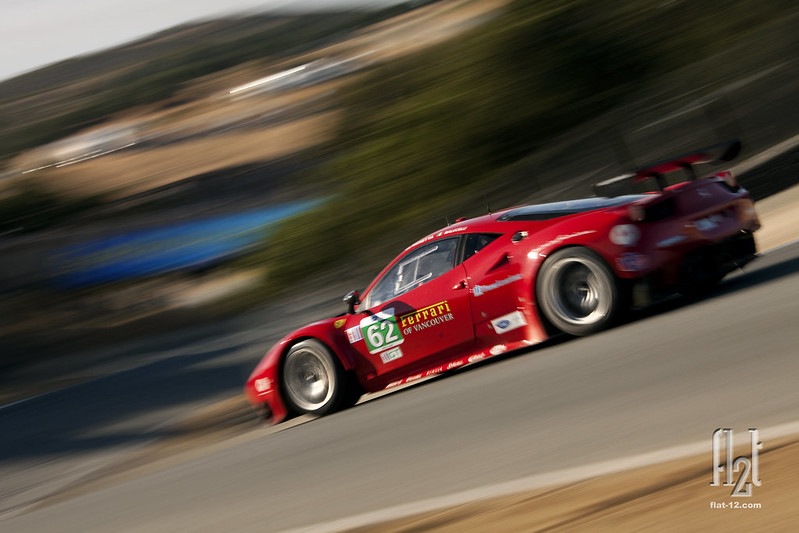 |
| Laguna Seca's corkscrew: renown for it's ten story drop |
Fabled names through great eras of modern motor sport have attacked this challenging ribbon of tarmac. Teams, designers, drivers, and automotive enthusiasts from all over the world have relished their moment under the Monterey sun, and this year's busy calendar will prove no exception.
May 11 marked one of the year's more significant annual events with the third round of the 2013 American Le Mans Series.. Bringing the most advanced prototypes and GT chassis from all over the world, the ALMS is the premiere North American sports car series contested by some of the world's best racing drivers.
Laguna Seca is one of only a handful of circuits to have hosted the ALMS each year of the series' fifteen-year existence. The circuit provides US sports car enthusiasts the opportunity to see these incredible machines driven on the limit over a highly unique terrain. The steep rise to the famous corkscrew turn challenges drivers and creates a natural spectator proscenium as the circuit sharply drops toward the Rainey curve.
Qualifying for this year's race was highlighted by two sensational pole position laps. Swiss pilot Neel Jani pipped the LMP1 field in his Rebellion Racing Lola-Toyota, while Italian Matteo Malucelli put his Risi Competizione Ferrari 458 GT on top in the GT class.
 |
| LMP1 Pole for Neel Jani |
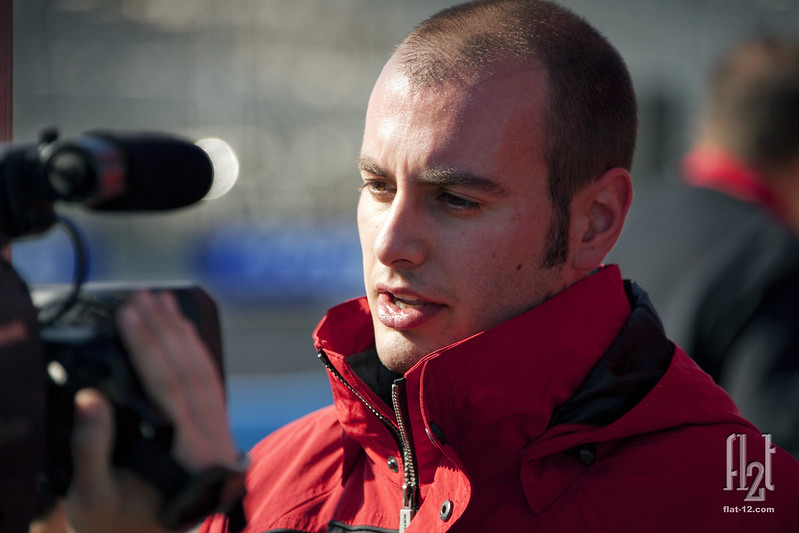 |
| Matteo Malucelli |
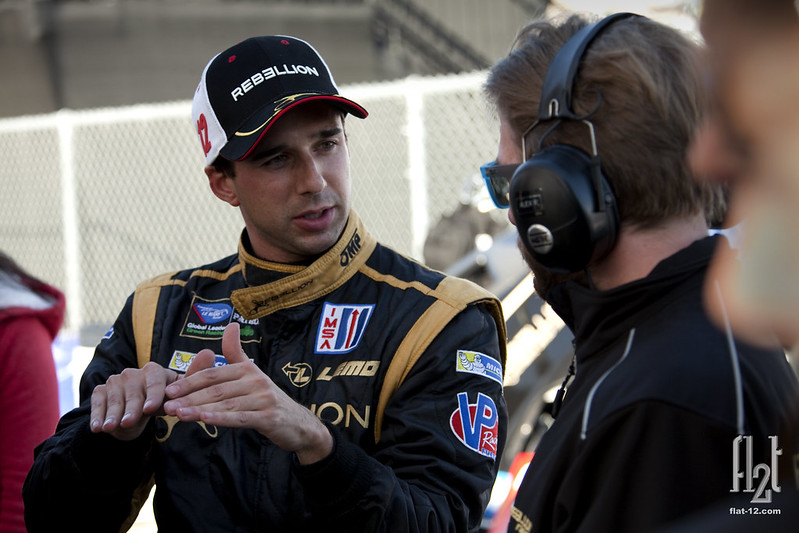 |
| Jani relates his pole lap to Heidfeld |
Germans Lucas Luhr and Klaus Graf in the Muscle Milk Honda HPD prototype wrestled the race win away from Jani and his teammate, ex-F1 pilot Nick Heidfeld, in a taut wheel to wheel contest.
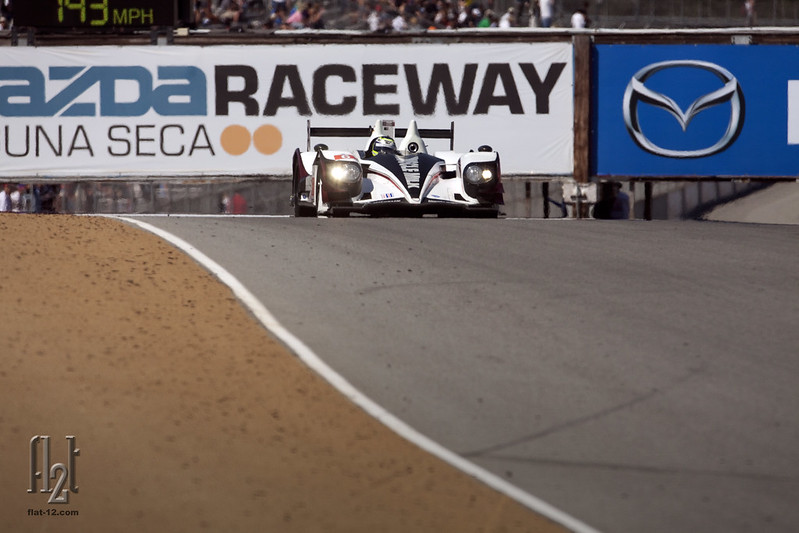 |
| Early days: Klaus Graf started for Muscle Milk |
Approaching traffic on entry to the corkscrew, Jani took to the inside but out braked himself. The Rebellion Lola missed the apex and Luhr slipped past. Jani later regained the race lead after the two cars came together into turn 3, but fell victim to a late race puncture leaving Rebellion to settle for second place behind the Luhr/Graf Muscle Milk Team.
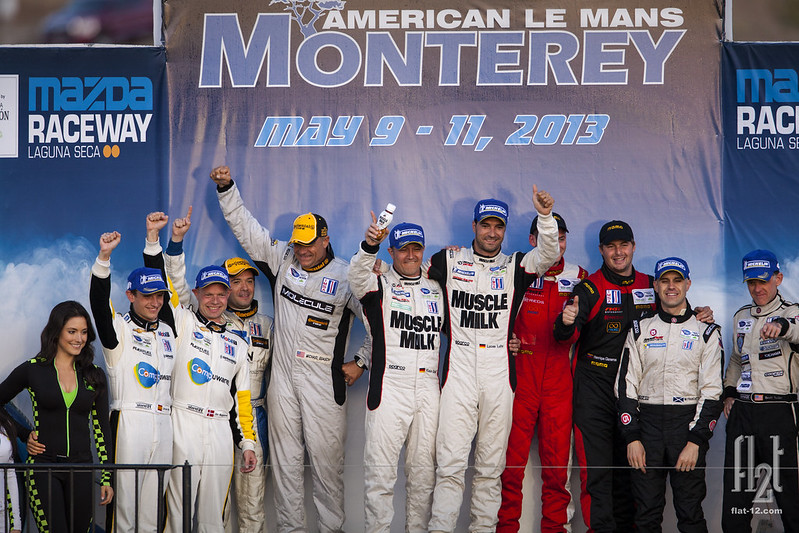 |
| Winning drivers from all classes |
IMSA's fantastic Porsche GT3 Cup and the Cooper Lites Championship both provided their usual brand of fierce competition filling out the race weekend. Featuring two races each, these support series feature close, often dramatic racing between semi-pro and gentlemen racers.
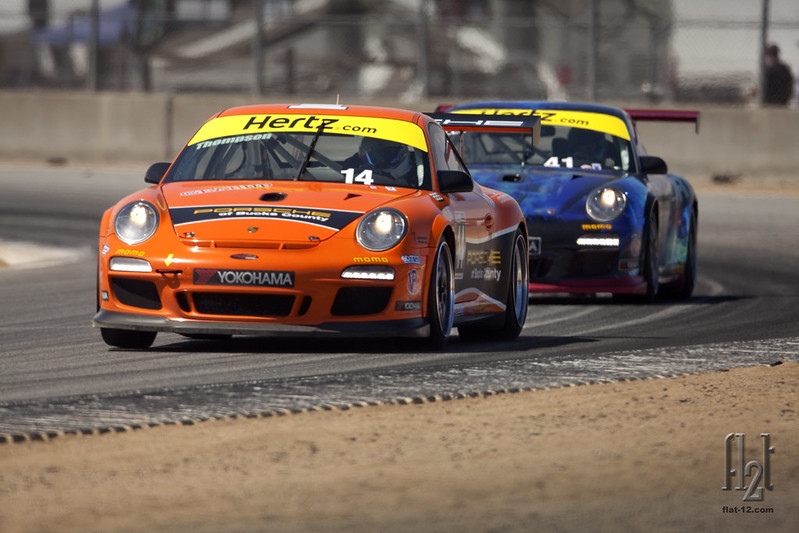 |
| IMSA's GT3 Cup supports the ALMS weekend with close racing |
This year's race marked the final ALMS visit to Mazda Raceway following the recent merger of ALMS with the NASCAR-sanctioned Grand AM series, which will launch IMSA United Sports Car Racing in 2014. Although the new series offers promise, it marks the end of what has proven to be a highly regarded facet of motor sport in North America.
 |
| Rebellion's Jani and Heidfeld were quick all weekend |
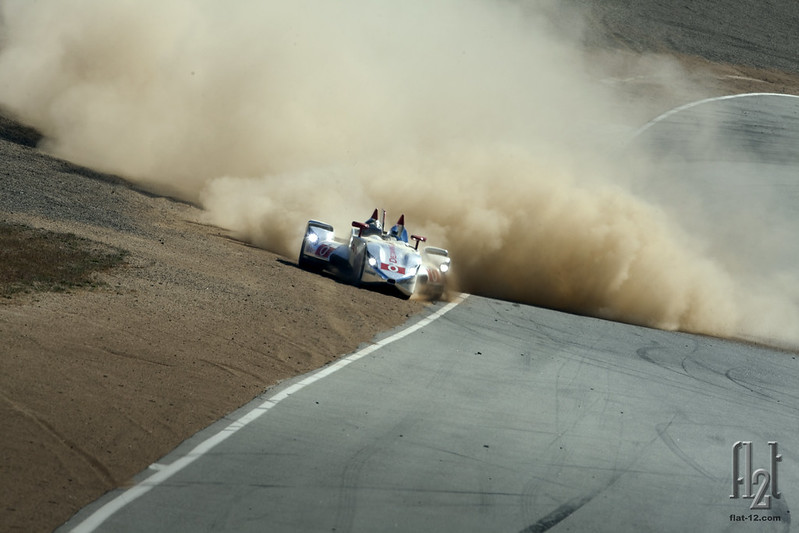 |
| Morning warm-up got a bit dusty for Katherine Legge in the DeltaWing LM12 |
 |
| Closing stages for the Team West/AJR/Boardwalk Ferrari 458 GT |
Story & Photos by
Jim Hunter
Labels:
ALMS,
American Le Mans Series,
DeltaWing,
GT3 Cup,
IMSA,
Klaus Graf,
Laguna Seca,
Lucas Luhr,
Matteo Malucelli,
Monterey,
Muscle Milk/Pickett Racing,
Neel Jani,
Nick Heidfeld,
Risi Competizione
Monday, October 7, 2013
Auto Gallery Dominates Sonoma
Originally published in the June, 2013 issue of DrivenWorld
May 2, 2013
Inspired by their strong start to the season, Auto Gallery Motorsports played momentum, focus, and team work to full advantage to achieve fantastic results in the third round of the North American Ferrari Challenge at Infineon Raceway, Sonoma.
Seasoned drivers John Farano and Carlos Kauffman both emerged victorious with race wins in the Trofeo Pirelli Championship.
Qualifying 2nd (Farano) and 4th (Kauffman), the Auto Gallery drivers staged an intense fight for the top step in Saturday’s first race.
Farano stated, “This (458 Challenge) is probably one of the nicest racecars I’ve ever driven and I’ve driven a few . . . a very, very enjoyable car to drive.” Farano relied on experience and race craft to hold off a determined attack from teammate Kauffman, keeping Carlos at bay entering the final chicane.
The team refused, however, to merely rest on their laurels. A very determined Kauffman laid down an invincible pole position lap for Sunday’s second race, “Yeah, I’m happy to be able to do it finally in the season. I really had a great lap. I heat up my tires, just came out, pretty nice, no traffic, inspired by yesterday’s race.”
Carlos drove a hard race to keep Ferrari Quebec’s Emmanuel Anassi and Ferrari of Houston’s Mark McKenzie at bay, taking his second 2013 race win thus giving The Auto Gallery both races for the Sonoma round. Commented Kauffman, “the cars are awesome, you know, it’s a Ferrari, you’re always glad to be on it.”
The team also did well in the Coppa Shell (Amateur) category, with first timer Jim Weiland finishing sixth in class.
Auto Gallery Motorsports is a close knit, cohesive team. Racing Director Ryan Negri and Crew Chief Rudy Courtade run a tightly focused operation, and are seasoned in what it takes to win.
“Ryan and I have been business partners for about 22 years. We started with Go-Karts and progressed into formula cars. We did some Porsche Motorsport stuff and then jumped into the Ferrari Challenge in 2000. We’re in a nice home with great support and a great dealership in the Auto Gallery,” said Courtade.
Negri added, “The biggest challenge really is staying ahead of the program, making sure the cars are ready, making sure that logistically we’re there, making sure that the cars are fast and reliable.”
Story & Images by
Jim Hunter
May 2, 2013
Inspired by their strong start to the season, Auto Gallery Motorsports played momentum, focus, and team work to full advantage to achieve fantastic results in the third round of the North American Ferrari Challenge at Infineon Raceway, Sonoma.
Seasoned drivers John Farano and Carlos Kauffman both emerged victorious with race wins in the Trofeo Pirelli Championship.
Qualifying 2nd (Farano) and 4th (Kauffman), the Auto Gallery drivers staged an intense fight for the top step in Saturday’s first race.
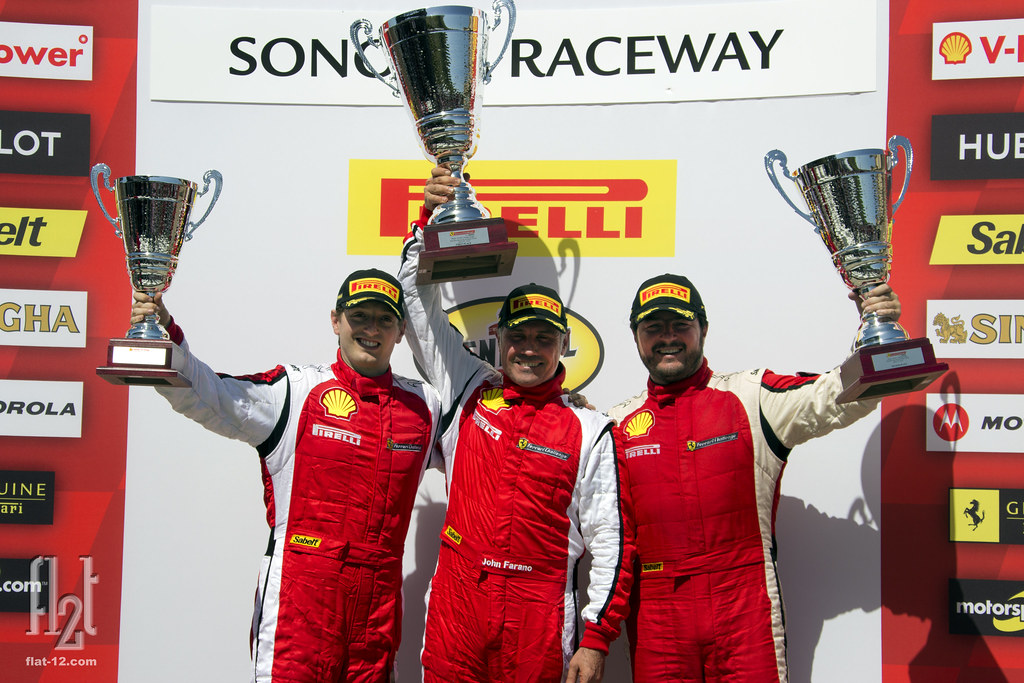 |
| Farano, center, Kauffman, right, celebrate Auto Gallery 1-2 Finish |
Farano stated, “This (458 Challenge) is probably one of the nicest racecars I’ve ever driven and I’ve driven a few . . . a very, very enjoyable car to drive.” Farano relied on experience and race craft to hold off a determined attack from teammate Kauffman, keeping Carlos at bay entering the final chicane.
The team refused, however, to merely rest on their laurels. A very determined Kauffman laid down an invincible pole position lap for Sunday’s second race, “Yeah, I’m happy to be able to do it finally in the season. I really had a great lap. I heat up my tires, just came out, pretty nice, no traffic, inspired by yesterday’s race.”
 |
| Pole position assured, Kauffman parks his steed well prior the end of session |
Carlos drove a hard race to keep Ferrari Quebec’s Emmanuel Anassi and Ferrari of Houston’s Mark McKenzie at bay, taking his second 2013 race win thus giving The Auto Gallery both races for the Sonoma round. Commented Kauffman, “the cars are awesome, you know, it’s a Ferrari, you’re always glad to be on it.”
 |
| Kauffman leads Anassi and McKenzie |
 |
| Kauffman accepts trophy for Sunday's victory from Ferrari of North America's Marco Mattiacci |
The team also did well in the Coppa Shell (Amateur) category, with first timer Jim Weiland finishing sixth in class.
Auto Gallery Motorsports is a close knit, cohesive team. Racing Director Ryan Negri and Crew Chief Rudy Courtade run a tightly focused operation, and are seasoned in what it takes to win.
 |
| Courtade and Negri: at home with The Auto Gallery |
“Ryan and I have been business partners for about 22 years. We started with Go-Karts and progressed into formula cars. We did some Porsche Motorsport stuff and then jumped into the Ferrari Challenge in 2000. We’re in a nice home with great support and a great dealership in the Auto Gallery,” said Courtade.
Negri added, “The biggest challenge really is staying ahead of the program, making sure the cars are ready, making sure that logistically we’re there, making sure that the cars are fast and reliable.”
Story & Images by
Jim Hunter
Labels:
458,
458 Challenge,
Auto Gallery Motorsports,
Carlos Kauffman,
Ferrari,
Ferrari Challenge,
Ferrari Challenge North America,
Infineon Raceway,
John Farano,
Rudy Courtade,
Ryan Negri,
Sonoma,
The Auto Gallery
Wednesday, April 3, 2013
...of Hypercars & Countach posters
The unveiling of Ferrari's limited series hypercar "LaFerrari" at the 2013 Geneva Motor Show may have challenged the single minded character of today's high end sports car market.
LaFerrari looks like a Le Mans prototype; its DNA is derivative of almost everything Ferrari have learned in competition. Even among fierce competitors so exacting in their technological precision, LaFerrari's promise of horsepower, speed, agility, and energy efficiency is immediately astounding.
The McLaren F1 remains to this day, performance wise, one of the most astounding road cars ever produced. It boldly stated that form can and should follow function, not the other way around.
Flash forward to 2013, and McLaren have also recently rolled out their hyper car, the "P1." Counting the MP4-12C and it's accompanying Spider version . . . the P1 arrives as McLaren's third entry since becoming a complete automobile and drivetrain constructor.
If LaFerrari and P1 have one thing in common, it's that they were largely developed in wind tunnels by computers. Both cars produce staggering performance; both cars utilize cutting edge technology to push beyond boundaries we've come to expect from the most advanced road going automobiles. They are derivative of the Murray approach in that they are the pure in their pursuit of pace.
Reaction to "LaFerrari" and the McLaren "P1" has been largely mixed. Christened with high concept names, embarrassed skepticism has rippled across the internet. It is immediately clear that neither moniker resonates with enthusiasts, and it is more likely that the true problems with those names reside far below the surface.
Today, Ferrari, McLaren, and host of other ambitious manufacturers find themselves embroiled in a game which shames shortcomings to the most minute, infinitesimal increments. Should either of these manufacturers dare produce a vehicle that sheds .001 g in cornering ability, they would find themselves roasted on a skewer across web blogs and the international motoring press.
Have we become so seduced by technology born performance that the notion of taking LaFerrari on a casual twilight drive along the coast seems absurd? For those lucky enough to drive or own a modern hyper car, how many of their glorious afternoon trips up the coast will be timed by anyone aside from revenue seeking police officers? Record shattering statistics make headlines and produce tingly sensations, but what criteria truly define a great automobile, especially a great sports car, especially among die hard enthusiasts? We all know performance is important, but what of styling?
More importantly, will these owners prove capable enough as drivers as to begin to taste the limits of these cars safely? With rare exception, I'd guess not.
I wonder whether manufacturers and enthusiasts alike have so fallen prey to media frenzy and focus group marketing to lose sight of the fact that there is indeed something more to the enthusiast experience than strict performance? Truly great cars are often elusive, almost accidental, and beyond the reach of technology, public opinion, and marketing objectives.
There was a time when styling might have had slightly less mathematical objective.
The Petersen Automotive Museum and the Southwest region of the Ferrari Club of America recently hosted a Ferrari Cruise-in in honor of the late Commendatore's birthday.
A reasonable number of SoCal Ferraristi risked Mid-Wilshire potholes, pedestrians, and errant LA drivers to bring their cars, representing almost every era, for a casual celebration across the top of the Petersen parking structure. From the early 60's 250 GT Lusso to more recent examples of the FF and 458 Spider, the casual gathering allowed owners and visitors a chance to appreciate the marque which has inspired and influenced the dreams of enthusiasts for decades.
James May waxes emotionally about the 250 California's peculiar eccentricities . . . almost as if he's reciting a litany of everything the car does which would certainly be distilled in today's approach. May is at no loss when pointing out aspects of the car which would make modern engineers cringe, and he does so with a huge grin, enthusiastically tossing out terms such as magical and fantastic to describe the driving experience. May aptly states: "the performance is not about the figures, it's about the nature of the delivery."
The reward in driving great sports cars might not be so much their performance but instead their raw, pre-technology, visceral feedback. It might also be found in the styling and materials utilized which have nothing to do with performance. I would argue that unique personality traits, more so than the degree to which they translate into performance, actually define the enthusiast experience.
Of course, I'm certain that both LaFerrari and P1 serve up gobs of visceral feedback. I'm also certain that they are both astonishing automobiles, and I've no real issue with their performance-born styling. However, I do wonder whether we'll ever see a hypercar which celebrates that casual twilight drive along the coast as much as it does defying the laws of physics.
LaFerrari looks like a Le Mans prototype; its DNA is derivative of almost everything Ferrari have learned in competition. Even among fierce competitors so exacting in their technological precision, LaFerrari's promise of horsepower, speed, agility, and energy efficiency is immediately astounding.
Ferrari revel in their competition history. It was once claimed that Ferrari built and sold road cars strictly to finance their racing operations. Over six decades in F1 and sports car racing, Ferrari have faced many competitors, but probably none more tenacious than McLaren. Over that same period Ferrari also built and sold many of the world's most revered sportscars. Ferrari "the brand," is defined by speed, exceptional performance, beauty, and a legendary history in motor sport competition.
By contrast, McLaren have only recently entered the high end sports car market despite their own lengthy and storied history building racing cars. Much like their posture in the F1 World Championship, McLaren have entered the game straight away targeting Ferrari. It is because McLaren lack decades and eras in their approach to producing road cars that they provide a great reference marque for this story.
McLaren's first road car, the BMW powered F1, actually came in the early 90's and was designed by Gordan Murray. The car was sort of a one-off, backed by McLaren Supremo Ron Dennis at a time when McLaren was not focused upon making road cars. Scarcely over 100 examples were made, and McLaren as a company did not introduce any other such vehicle once construction was discontinued in 1998.
Murray is renown for his innovative thinking when it comes to designing racing cars. His incorporation of Jim Hall's Chaparral 2J into the Brabham-Alfa Romeo BT 46 resulted in a fan car that demolished it's competition in a single outing before being deemed illegal and thus retired to the history books. Murray mounted a large powerful fan to the rear of the BT 46 chassis to answer Colin Chapman's then all dominant ground effect Lotus 79. The fan literally sucked all of the air pressure from underneath the car, thus gluing Niki Lauda to the circuit who had but to simply drive around the Lotus, as well as the entire field, to easily win the 1978 Swedish Grand Prix.
Murray later introduced the super low slung Brabham-BMW BT 55, in which he mounted the engine on it's side to allow less restrictive airflow over the vehicle. Although this car did not achieve success, Murray's design later came to fruition at McLaren, where he, the team, and Aryton Senna enjoyed great success with the MP4/4. The BT 55 can however be defined as the car which introduced the severely reclined, recumbent seating position we've now grown accustom to in modern F1 and prototype racing cars.
Yet despite these contributions to modern race car technology, Murray's McLaren F1 road car may prove his most influential design. The F1 arguably raised the influence of technology born performance in modern sports cars above all other considerations in a fashion the world had not previously seen. As the F1 arrived prior today's climate of logarithmically decreasing shelf life, its resulting legacy is only becoming more apparent with the passage of time.
Flash forward to 2013, and McLaren have also recently rolled out their hyper car, the "P1." Counting the MP4-12C and it's accompanying Spider version . . . the P1 arrives as McLaren's third entry since becoming a complete automobile and drivetrain constructor.
If LaFerrari and P1 have one thing in common, it's that they were largely developed in wind tunnels by computers. Both cars produce staggering performance; both cars utilize cutting edge technology to push beyond boundaries we've come to expect from the most advanced road going automobiles. They are derivative of the Murray approach in that they are the pure in their pursuit of pace.
Thus they also share another critical similarity . . . virtually no aspect of either vehicle exists outside that performance objective.
Today, Ferrari, McLaren, and host of other ambitious manufacturers find themselves embroiled in a game which shames shortcomings to the most minute, infinitesimal increments. Should either of these manufacturers dare produce a vehicle that sheds .001 g in cornering ability, they would find themselves roasted on a skewer across web blogs and the international motoring press.
More importantly, will these owners prove capable enough as drivers as to begin to taste the limits of these cars safely? With rare exception, I'd guess not.
I wonder whether manufacturers and enthusiasts alike have so fallen prey to media frenzy and focus group marketing to lose sight of the fact that there is indeed something more to the enthusiast experience than strict performance? Truly great cars are often elusive, almost accidental, and beyond the reach of technology, public opinion, and marketing objectives.
There was a time when styling might have had slightly less mathematical objective.
The Petersen Automotive Museum and the Southwest region of the Ferrari Club of America recently hosted a Ferrari Cruise-in in honor of the late Commendatore's birthday.
A reasonable number of SoCal Ferraristi risked Mid-Wilshire potholes, pedestrians, and errant LA drivers to bring their cars, representing almost every era, for a casual celebration across the top of the Petersen parking structure. From the early 60's 250 GT Lusso to more recent examples of the FF and 458 Spider, the casual gathering allowed owners and visitors a chance to appreciate the marque which has inspired and influenced the dreams of enthusiasts for decades.
Computers and wind tunnels are valuable, worthwhile tools, but if one were to step back, stroll amongst these machines, and recall the excellent segment Top Gear produced on the ex-James Coburn Ferrari 250 California, it's hard to escape that the sense that something is missing.
The reward in driving great sports cars might not be so much their performance but instead their raw, pre-technology, visceral feedback. It might also be found in the styling and materials utilized which have nothing to do with performance. I would argue that unique personality traits, more so than the degree to which they translate into performance, actually define the enthusiast experience.
Of course, I'm certain that both LaFerrari and P1 serve up gobs of visceral feedback. I'm also certain that they are both astonishing automobiles, and I've no real issue with their performance-born styling. However, I do wonder whether we'll ever see a hypercar which celebrates that casual twilight drive along the coast as much as it does defying the laws of physics.
Monday, December 10, 2012
Flat-12 Top Ten
Based solely upon the last three Grands Prix (Abu Dhabi, USA, Brazil), I'd bet that the 2012 F1 season could be safely typeset into almanacs and encyclopedias two decades from now as a remarkable year. 2012 delivered a lot of surprises, and one of the greatest ironies is that two of the best races occurred at Valencia and Abu Dhabi, circuits most commonly regarded for producing boring processions.
Although Sebastian Vettel held the narrowest of point margins as the teams began the European season, his 2012 was shaping up nothing like the casual romp he enjoyed in 2011. He initially appeared to struggle, and was often out paced by his teammate. However as the teams reached Hungary there were subtle indications that Vettel was back on form and on the rise. Vettel's season actually began at Spa, the moment Alonso fell victim to Grosjean's crazy, hell bent start.
Vettel and Red Bull emerged from the summer break ready to capitalize on the post European season and in doing so they cemented Seb's place in the history books. In contrast to my thoughts on Hamilton, I'd long been a fan of Sebastian Vettel. People and times do certainly change. It's fair to say that my growing appreciation for Lewis Hamilton in 2012 was balanced by my growing depreciation for Sebastian Vettel.
The truth of the matter is Vettel remains an exceptional talent, certainly one of the best. Although questions regarding his abilities to fight from behind have been fairly drawn, he has in my mind adequately demonstrated himself to be very much a complete driver.
Unfortunately, the more I get to know Seb, the less I like him. Dare I suggest he's growing overly arrogant and borderline obnoxious? IMHO, He carries two demons on his shoulder like a poster child for the unwitting:
The first of which has been his abnormal good fortune. Vettel has enjoyed not just run of the mill good luck, but instead the sort of fortune the universe does not dole out very often, nor indefinitely. Vettel is riding a wave that is eventually going to have a fairly hard, rapid crash.
The second demon is Seb's ego. All of this good fortune has gone to his head. From my vantage point he does not quite see reality. Granted, we all can have difficulty seeing our paths objectively, and among us F1 drivers generally tend to be a bit more ego-centric. Unfortunately, a heady, over inflated self image can betray one's focus and determination, and if Seb can't keep his in check he may soon realize his own zenith to be fleeting.
A fair perspective would recognize that Vettel drove great in Abu Dhabi, but his ascent to the podium was primarily the result of an unusually large number of reasonable foes falling victim to retirement or repair. (It is also no secret that Vettel enjoys a slight advantage also having two Toro Rosso's who will always jump out of his way).
A fair perspective would acknowledge that he was incredibly lucky to have not retired at Interlagos from the first lap accident of his own making. Yes, I'm sure there is debate over "own making;" I'd be happy to engage that topic in follow up comments.
In both instances, Seb did well to recover . . . but strictly speaking his performance level has been over blown to mythical proportions. Let's not forget that his Interlagos recovery included those same Toro Rosso's and a parting gift from Michael Schumacher, who apparently must not have been anticipating a post retirement career at Ferrari.
Am I unfair? Hardly. Vettel is a rare talent. Is he head and shoulders above Alonso, Räikkönen, Hamilton? No. Did he earn the 2012 Driver's Title? Yes. He is a deserved World Champion. Did he merit that title above all others? No, but championships often go that way.
He is the 2012 World Driving Champion, the youngest three time champion ever, and I congratulate him for his historical achievement.
With the season now complete and Sebastian Vettel claiming his third straight world driving title, the time has come once again for armchair analysis.
Enter the 2012 edition of the Flat-12 Top Ten. A highly subjective, passionate summary utilizing the latest time proven techniques (beer) to measure the following criteria: level of performance, consistency of performance, ability to overcome adversity (in terms of car, weather, etc.), and avoiding mistakes.
There's a lot of time wasted on compiling such useless lists, but sit back, grab those beer goggles, and join in with your own amateur punditry.
Anyway, I'm linking this post to the Torque F1 Top Ten, for an alternate, perhaps less "hoppy" perspective.
There's a lot of time wasted on compiling such useless lists, but sit back, grab those beer goggles, and join in with your own amateur punditry.
Anyway, I'm linking this post to the Torque F1 Top Ten, for an alternate, perhaps less "hoppy" perspective.
1) Fernando Alonso
I've been following F1 a long time. A real long time. I can identify world champions who conquered even when they did not have the best car before I can tie my shoes.
Lauda in 1977, Piquet in 1981, Senna in 1991, and Raikkonen in 2007 are but a few who come immediately to mind. There were non-champion drivers such as Villeneuve who toiled bravely with the wretched 1981 Ferrari 126CK, Senna literally willing pole position at Imola from his schizo Williams prior that fateful day in 1994 . . .
Yet despite all prior examples of man over machinery I can quickly produce, I wonder if any driver at any time has overcome a car so wayward as the F2012 Ferrari to come so close to winning it all?
Fernando is a better driver now than when he won back to back titles at Renault. His race starts are unbelievable and his tenacity is absolute. As with all great drivers he's made a few enemies along the way, but I have no doubt that Fernando Alonso put together the most complete performance of 2012.
Arguably Fernando made only one costly mistake all year long: leaving Räikkönen no where to go into turn 1 at Suzuka. Many also contend that his title was lost in the first corner melee at Spa. Certainly, Spa was a race Alonso could have won and most certainly achieved a podium result, so the fact that he came away from both of these races empty handed is significant.
However, if we allow that a couple of DNF's might be expected over a 20 race calendar, Monza may have inflicted the most subliminal damage. Alonso was quickest all weekend, until Q3 . . . and although some doubt lingers over what actually happened, the loss of his expected pole position and almost certain victory hurt. Further losing 2nd place and 3 points to Perez only added insult to injury.
I've been following F1 a long time. A real long time. I can identify world champions who conquered even when they did not have the best car before I can tie my shoes.
Lauda in 1977, Piquet in 1981, Senna in 1991, and Raikkonen in 2007 are but a few who come immediately to mind. There were non-champion drivers such as Villeneuve who toiled bravely with the wretched 1981 Ferrari 126CK, Senna literally willing pole position at Imola from his schizo Williams prior that fateful day in 1994 . . .
Yet despite all prior examples of man over machinery I can quickly produce, I wonder if any driver at any time has overcome a car so wayward as the F2012 Ferrari to come so close to winning it all?
Fernando is a better driver now than when he won back to back titles at Renault. His race starts are unbelievable and his tenacity is absolute. As with all great drivers he's made a few enemies along the way, but I have no doubt that Fernando Alonso put together the most complete performance of 2012.
Arguably Fernando made only one costly mistake all year long: leaving Räikkönen no where to go into turn 1 at Suzuka. Many also contend that his title was lost in the first corner melee at Spa. Certainly, Spa was a race Alonso could have won and most certainly achieved a podium result, so the fact that he came away from both of these races empty handed is significant.
However, if we allow that a couple of DNF's might be expected over a 20 race calendar, Monza may have inflicted the most subliminal damage. Alonso was quickest all weekend, until Q3 . . . and although some doubt lingers over what actually happened, the loss of his expected pole position and almost certain victory hurt. Further losing 2nd place and 3 points to Perez only added insult to injury.
2) Kimi Räikkönen
Räikkönen very nearly found himself leading the Driver's Championship one quarter of the way into the year. The Lotus looked exceptionally quick at certain times, on certain circuits, but overall the car simply was not ready to run at the front. Yet Kimi managed, much like Alonso, to turn mid field qualifying positions into podium finishes. Räikkönen drove with great control all year long. Fighting for position, he always did so with sublime precision, never once guilty of putting a competitor off, although many still blame him for Suzuka. His pass on Schumacher into Eau Rouge, move around the outside of Di Resta through the twisty bits in Austin, and his final wheel to wheel exchange with Schumi at Interlagos are but several glorious displays of a driving prowess that F1 missed in 2010 and 2011.
It is for Kimi's consistency and phenomenal precision over the course of the entire season which stand foremost in my mind.
Räikkönen very nearly found himself leading the Driver's Championship one quarter of the way into the year. The Lotus looked exceptionally quick at certain times, on certain circuits, but overall the car simply was not ready to run at the front. Yet Kimi managed, much like Alonso, to turn mid field qualifying positions into podium finishes. Räikkönen drove with great control all year long. Fighting for position, he always did so with sublime precision, never once guilty of putting a competitor off, although many still blame him for Suzuka. His pass on Schumacher into Eau Rouge, move around the outside of Di Resta through the twisty bits in Austin, and his final wheel to wheel exchange with Schumi at Interlagos are but several glorious displays of a driving prowess that F1 missed in 2010 and 2011.
It is for Kimi's consistency and phenomenal precision over the course of the entire season which stand foremost in my mind.
3) Lewis Hamilton
I've long been a critic of Lewis Hamilton. I never cared for his methods during his early days at McLaren and still feel that he threw Dave Ryan under the bus. I always believed he was over-rated and possessed an uncanny knack to flatten brakes and blister tires. However, times and people change.
Despite a rather uneven 2012 season, Lewis managed to pull it all together by season's end and very nearly won the last three Grands Prix in dominant fashion. His drive in Austin was without doubt the most determined, disciplined performance of his career.
Hamilton suffered inexplicable pit stop debacles early in the year, and costly technical failures in the latter. McLaren found themselves floundering mid-season, as demonstrated by their dreadful home race at Silverstone.
Despite all of this, I took notice of Hamilton's newfound reserve. His airborne hissy fits were greatly subdued if not all but gone by season's end. In year's prior, atrocious pit stops would have left Hamilton gasping for someone's head over the team radio. His off-track soap opera dramas, although taking a different form in terms of tweets, were in check and largely gone.
. . . and so are his days at McLaren.
I don't know what fortunes lie in wait for Lewis at Mercedes, but it's hard to fault his decision. All one needs to do is take a stroll through the F1 Village at any Grand Prix to realize that McLaren demanded too much in restricting his ability to capitalize on the Lewis Hamilton brand. My hats off to Lewis for making a tough decision . . . my guess is that he will find himself fighting to get into Q3 instead fighting for pole for much of 2013.
4) Sebastian Vettel
I've long been a critic of Lewis Hamilton. I never cared for his methods during his early days at McLaren and still feel that he threw Dave Ryan under the bus. I always believed he was over-rated and possessed an uncanny knack to flatten brakes and blister tires. However, times and people change.
Despite a rather uneven 2012 season, Lewis managed to pull it all together by season's end and very nearly won the last three Grands Prix in dominant fashion. His drive in Austin was without doubt the most determined, disciplined performance of his career.
Hamilton suffered inexplicable pit stop debacles early in the year, and costly technical failures in the latter. McLaren found themselves floundering mid-season, as demonstrated by their dreadful home race at Silverstone.
Despite all of this, I took notice of Hamilton's newfound reserve. His airborne hissy fits were greatly subdued if not all but gone by season's end. In year's prior, atrocious pit stops would have left Hamilton gasping for someone's head over the team radio. His off-track soap opera dramas, although taking a different form in terms of tweets, were in check and largely gone.
. . . and so are his days at McLaren.
I don't know what fortunes lie in wait for Lewis at Mercedes, but it's hard to fault his decision. All one needs to do is take a stroll through the F1 Village at any Grand Prix to realize that McLaren demanded too much in restricting his ability to capitalize on the Lewis Hamilton brand. My hats off to Lewis for making a tough decision . . . my guess is that he will find himself fighting to get into Q3 instead fighting for pole for much of 2013.
4) Sebastian Vettel
Although Sebastian Vettel held the narrowest of point margins as the teams began the European season, his 2012 was shaping up nothing like the casual romp he enjoyed in 2011. He initially appeared to struggle, and was often out paced by his teammate. However as the teams reached Hungary there were subtle indications that Vettel was back on form and on the rise. Vettel's season actually began at Spa, the moment Alonso fell victim to Grosjean's crazy, hell bent start.
Vettel and Red Bull emerged from the summer break ready to capitalize on the post European season and in doing so they cemented Seb's place in the history books. In contrast to my thoughts on Hamilton, I'd long been a fan of Sebastian Vettel. People and times do certainly change. It's fair to say that my growing appreciation for Lewis Hamilton in 2012 was balanced by my growing depreciation for Sebastian Vettel.
The truth of the matter is Vettel remains an exceptional talent, certainly one of the best. Although questions regarding his abilities to fight from behind have been fairly drawn, he has in my mind adequately demonstrated himself to be very much a complete driver.
Unfortunately, the more I get to know Seb, the less I like him. Dare I suggest he's growing overly arrogant and borderline obnoxious? IMHO, He carries two demons on his shoulder like a poster child for the unwitting:
The first of which has been his abnormal good fortune. Vettel has enjoyed not just run of the mill good luck, but instead the sort of fortune the universe does not dole out very often, nor indefinitely. Vettel is riding a wave that is eventually going to have a fairly hard, rapid crash.
The second demon is Seb's ego. All of this good fortune has gone to his head. From my vantage point he does not quite see reality. Granted, we all can have difficulty seeing our paths objectively, and among us F1 drivers generally tend to be a bit more ego-centric. Unfortunately, a heady, over inflated self image can betray one's focus and determination, and if Seb can't keep his in check he may soon realize his own zenith to be fleeting.
A fair perspective would recognize that Vettel drove great in Abu Dhabi, but his ascent to the podium was primarily the result of an unusually large number of reasonable foes falling victim to retirement or repair. (It is also no secret that Vettel enjoys a slight advantage also having two Toro Rosso's who will always jump out of his way).
A fair perspective would acknowledge that he was incredibly lucky to have not retired at Interlagos from the first lap accident of his own making. Yes, I'm sure there is debate over "own making;" I'd be happy to engage that topic in follow up comments.
In both instances, Seb did well to recover . . . but strictly speaking his performance level has been over blown to mythical proportions. Let's not forget that his Interlagos recovery included those same Toro Rosso's and a parting gift from Michael Schumacher, who apparently must not have been anticipating a post retirement career at Ferrari.
Am I unfair? Hardly. Vettel is a rare talent. Is he head and shoulders above Alonso, Räikkönen, Hamilton? No. Did he earn the 2012 Driver's Title? Yes. He is a deserved World Champion. Did he merit that title above all others? No, but championships often go that way.
He is the 2012 World Driving Champion, the youngest three time champion ever, and I congratulate him for his historical achievement.
5) Nico Hulkenberg
The strongest statement I can make about Nico Hulkenberg is Paul di Resta. A formidable talent, di Resta looked the stronger of the Force India pair over the early part of the year, but much like Vettel, Hulkenberg sprung to life gaining a career best 4th place at Spa followed by a good run of points finishes in the post European fly away season. He won the BBC "Overtake of the Year" award for his move past Grosjean & Hamilton in Korea. His charge to the lead in the wet Brazil conditions was spectacular, albeit cut short by clashing with Hamilton into the Senna "S."
Hulkenberg eclipsed di Resta (originally rumored as headed to McLaren) in silly season prognostication. As Perez emerged as Hamilton's McLaren successor, many suggested that they should have instead chosen Hulkenberg instead. Ironic indeed, as it was as if Paul di Resta had never been in the frame for the seat.
Hulkenberg jumps to Sauber for 2013, and I expect him to do quite well.
The strongest statement I can make about Nico Hulkenberg is Paul di Resta. A formidable talent, di Resta looked the stronger of the Force India pair over the early part of the year, but much like Vettel, Hulkenberg sprung to life gaining a career best 4th place at Spa followed by a good run of points finishes in the post European fly away season. He won the BBC "Overtake of the Year" award for his move past Grosjean & Hamilton in Korea. His charge to the lead in the wet Brazil conditions was spectacular, albeit cut short by clashing with Hamilton into the Senna "S."
Hulkenberg eclipsed di Resta (originally rumored as headed to McLaren) in silly season prognostication. As Perez emerged as Hamilton's McLaren successor, many suggested that they should have instead chosen Hulkenberg instead. Ironic indeed, as it was as if Paul di Resta had never been in the frame for the seat.
Hulkenberg jumps to Sauber for 2013, and I expect him to do quite well.
6) Jenson Button
Jenson had an up and down year, and lands sixth on my list primarily due to that inconsistency. He had a number of magnificent drives, the sort many have to come to expect given his highly disciplined race craft. Button usually excels in changeable conditions, therefore his dominance in a very dry, very clear Belgian Grand Prix was surprising. So strong was Jenson at Spa that I'm not certain, had Hamilton and Alonso survived the first corner, that they could have caught him on that day.
Jenson now clearly leads McLaren into 2013. I believe that his maturity, race craft, and calm demeanor will serve McLaren well . . . but all of these will be pale if Jenson can not find consistent pace at the front. He's got a huge challenge ahead, but may also have the best car on the grid.
We've seen what can happen when Jenson has such a car.
7) Sergio Perez
Sergio had moments of brilliance. Malaysia was in fact one of those classic F1 "arrival" moments, where a driver graduates into the realm of potential greatness. Sergio also performed exceedingly well taking 2nd (and potentially the title) from Alonso at Monza, earning Niki Lauda's admiration in the process.
Unfortunately, Perez then struggled following his strong showing in Italy and the announcement of his move to McLaren. Races such as Brazil (unfortunate victim) Abu Dhabi (unfortunate perpetrator) are best forgotten. His final point for 2012 and for Sauber came with a less than impressive 10th place in Singapore. Singapore? In hindsight, that is almost unbelievable.
Anyway, it will be interesting to see how Sergio goes at McLaren. I believe the potential for greatness in Perez remains strong, but the realization will be dependent upon his stock of this year's lessons. He appears to be a master at preserving his tires . . . and if he can tie all the loose ends together around that rare skill, he could grow to become unbeatable with the right team.
8) Nico Rosberg
At the moment Nico captured his first F1 victory in Shanghai, it appeared that Mercedes had indeed come into 2012 a contender. Unfortunately, that contention seemed to evaporate almost immediately afterwards.
Nico remains a difficult talent to judge, however I believe that his slight edge over Schumacher during their three years as teammates is significant. I strongly suspect that Hamilton has a surprise waiting at Mercedes; he will find Nico a hard teammate to beat.
Mercedes as a team are equally difficult to pin down. They more closely resemble their former iteration as Honda than the singular success of 2009 under the title winning moniker of Brawn GP.
One can only imagine what factors contribute to this, but until Nico Rosberg lands within a truly competitive environment, I'm not sure we'll know much more about his true potential either.
9) Felipe Massa
Felipe gets major kudos for his startling, sensational return to form. For a driver whose career looked finished . . . seriously beyond hope . . . the manner in which Massa finally recovered to discover faster pace than his title contending teammate begs recognition.
Massa's driving in the opening laps at Interlagos was outstanding. The manner in which he and Alonso worked off each other against Webber was something to behold.
Ferrari have stuck by Felipe over difficult times. Accordingly, he has played the team role in return. It will be very interesting to see how 2013 plays out within the Scuderia if he continues to improve.
10) Mark Webber
Webber looked stronger than ever, and arguably worse than ever, all in one season.
On all counts he should place higher on my list than 10th, but the pitfalls of 2012 were so drastic he almost did not make the list at all.
His victories at Silverstone and Monaco were well deserved. He took advantage of Alonso's tire woes to mount victory charge worthy of the year end highlight reel. He capitalized on Michael Schumacher's grid penalty to turn an inherited pole position grid slot into an almost uncontested victory.
Unfortunately, Singapore and Abu Dhabi contrast sharply, and his drive in Abu Dhabi might qualify as the one of the worst by any driver all year long.
He had a fair number of characteristically bad starts . . . I've often suggested that he needs to quit focusing on his post retirement broadcast career, but if Mark didn't talk to Brundle, Buxton, or Coulthard, I'm not sure who would.
Webber is one of the good guys, a real benefit to the sport, and I'm hoping that he ultimately enjoys the success he deserves. Conversely, I'm cynical enough to know that won't happen at Red Bull.
Elsewhere along the grid . . .
Pastor Maldonado scored an impressive first victory in Spain, but I found his overall performance in what looked to be a fairly competitive Williams disappointing.
Paul di Resta struggled, although I would imagine his results don't properly reflect his resolve . . .
Kobayashi had moments . . . he drove very well under pressure to hold off a quickly closing Button at Suzuka to take his very first podium in his home race . . . a real highlight of the season.
Grosjean showed remarkable pace and had he kept things a bit more tidy (understatement), I would've have acknowledged that potential above.
Schumacher set the fastest quail time for Monaco and scored the only podium result of his return in Valencia, but was never really in contention, and not really a candidate for top ten consideration. More thoughts here.
Finally, there are some drivers I just don't have a strong enough grasp for when compiling such summaries . . . Ricciardo, Kovalainen, Glock, Petrov.
Jenson had an up and down year, and lands sixth on my list primarily due to that inconsistency. He had a number of magnificent drives, the sort many have to come to expect given his highly disciplined race craft. Button usually excels in changeable conditions, therefore his dominance in a very dry, very clear Belgian Grand Prix was surprising. So strong was Jenson at Spa that I'm not certain, had Hamilton and Alonso survived the first corner, that they could have caught him on that day.
Jenson now clearly leads McLaren into 2013. I believe that his maturity, race craft, and calm demeanor will serve McLaren well . . . but all of these will be pale if Jenson can not find consistent pace at the front. He's got a huge challenge ahead, but may also have the best car on the grid.
We've seen what can happen when Jenson has such a car.
7) Sergio Perez
Sergio had moments of brilliance. Malaysia was in fact one of those classic F1 "arrival" moments, where a driver graduates into the realm of potential greatness. Sergio also performed exceedingly well taking 2nd (and potentially the title) from Alonso at Monza, earning Niki Lauda's admiration in the process.
Unfortunately, Perez then struggled following his strong showing in Italy and the announcement of his move to McLaren. Races such as Brazil (unfortunate victim) Abu Dhabi (unfortunate perpetrator) are best forgotten. His final point for 2012 and for Sauber came with a less than impressive 10th place in Singapore. Singapore? In hindsight, that is almost unbelievable.
Anyway, it will be interesting to see how Sergio goes at McLaren. I believe the potential for greatness in Perez remains strong, but the realization will be dependent upon his stock of this year's lessons. He appears to be a master at preserving his tires . . . and if he can tie all the loose ends together around that rare skill, he could grow to become unbeatable with the right team.
8) Nico Rosberg
At the moment Nico captured his first F1 victory in Shanghai, it appeared that Mercedes had indeed come into 2012 a contender. Unfortunately, that contention seemed to evaporate almost immediately afterwards.
Nico remains a difficult talent to judge, however I believe that his slight edge over Schumacher during their three years as teammates is significant. I strongly suspect that Hamilton has a surprise waiting at Mercedes; he will find Nico a hard teammate to beat.
Mercedes as a team are equally difficult to pin down. They more closely resemble their former iteration as Honda than the singular success of 2009 under the title winning moniker of Brawn GP.
One can only imagine what factors contribute to this, but until Nico Rosberg lands within a truly competitive environment, I'm not sure we'll know much more about his true potential either.
9) Felipe Massa
Felipe gets major kudos for his startling, sensational return to form. For a driver whose career looked finished . . . seriously beyond hope . . . the manner in which Massa finally recovered to discover faster pace than his title contending teammate begs recognition.
Massa's driving in the opening laps at Interlagos was outstanding. The manner in which he and Alonso worked off each other against Webber was something to behold.
Ferrari have stuck by Felipe over difficult times. Accordingly, he has played the team role in return. It will be very interesting to see how 2013 plays out within the Scuderia if he continues to improve.
10) Mark Webber
Webber looked stronger than ever, and arguably worse than ever, all in one season.
On all counts he should place higher on my list than 10th, but the pitfalls of 2012 were so drastic he almost did not make the list at all.
His victories at Silverstone and Monaco were well deserved. He took advantage of Alonso's tire woes to mount victory charge worthy of the year end highlight reel. He capitalized on Michael Schumacher's grid penalty to turn an inherited pole position grid slot into an almost uncontested victory.
Unfortunately, Singapore and Abu Dhabi contrast sharply, and his drive in Abu Dhabi might qualify as the one of the worst by any driver all year long.
He had a fair number of characteristically bad starts . . . I've often suggested that he needs to quit focusing on his post retirement broadcast career, but if Mark didn't talk to Brundle, Buxton, or Coulthard, I'm not sure who would.
Webber is one of the good guys, a real benefit to the sport, and I'm hoping that he ultimately enjoys the success he deserves. Conversely, I'm cynical enough to know that won't happen at Red Bull.
Elsewhere along the grid . . .
Pastor Maldonado scored an impressive first victory in Spain, but I found his overall performance in what looked to be a fairly competitive Williams disappointing.
Paul di Resta struggled, although I would imagine his results don't properly reflect his resolve . . .
Kobayashi had moments . . . he drove very well under pressure to hold off a quickly closing Button at Suzuka to take his very first podium in his home race . . . a real highlight of the season.
Grosjean showed remarkable pace and had he kept things a bit more tidy (understatement), I would've have acknowledged that potential above.
Schumacher set the fastest quail time for Monaco and scored the only podium result of his return in Valencia, but was never really in contention, and not really a candidate for top ten consideration. More thoughts here.
Finally, there are some drivers I just don't have a strong enough grasp for when compiling such summaries . . . Ricciardo, Kovalainen, Glock, Petrov.
With this 20 race season wrapping so late into the year, 2013 is just around the corner. I suspect that things will not change remarkably over the coming 12 months.
McLaren will probably have, generally speaking, the fastest car but will need to address their reliability issues. Red Bull will remain without doubt the strongest team on the grid. Ferrari will probably continue to struggle with tires. Lotus? Williams? Sauber?
2013 will bring Bottas (Williams), Gutierrez(Sauber), and potentially other new faces. Sadly we may lose Kobayashi and Kovalainen. Petrov's future is also far from certain. HRT is gone and perhaps, too, are de la Rosa and Kartikeyan. I'm concerned that the pay driver syndrome is taking a firmer grip on the sport.
The tables won't truly be turned upside down until the rules changes of 2014, which will introduce new, V-6 Turbo power plants.
McLaren will probably have, generally speaking, the fastest car but will need to address their reliability issues. Red Bull will remain without doubt the strongest team on the grid. Ferrari will probably continue to struggle with tires. Lotus? Williams? Sauber?
2013 will bring Bottas (Williams), Gutierrez(Sauber), and potentially other new faces. Sadly we may lose Kobayashi and Kovalainen. Petrov's future is also far from certain. HRT is gone and perhaps, too, are de la Rosa and Kartikeyan. I'm concerned that the pay driver syndrome is taking a firmer grip on the sport.
The tables won't truly be turned upside down until the rules changes of 2014, which will introduce new, V-6 Turbo power plants.
Friday, November 23, 2012
Era
His decision to retire for good is not all together a surprise . . . but I'd hoped he was to find a seat at Sauber and give it one more go.
I was fascinated with Michael when he first arrived in F1, but fell against him during his early days at Ferrari and the incredible battles with Mika Hakkinen in '98 and '99. I was at the time and remain to this day very impressed with Hakkinen as a driver and as a person. In hindsight, my favoritism probably wasn't as much a slight against Schumi as it was a nod for Hakkinen's merit as a competitor, as a sportsman.
It would prove, however, a few years later before I attended my very first Grand Prix: Imola 2004
I will never forget walking across the bridge toward the start/finish straight, hearing for the first time the ultra-violent, screaming banshee shrill of a Ferrari V-10 exiting the pits. By the time I'd launched into high gear to run inside the circuit to find the quickest perspective through an obstructing fence, Schumi blasted by at absolute flat chat. It was surreal.
 |
| Schumi on his way to another uncontested victory at Imola in the V-10 F2004 |
Therefore, it was only during the latter third of his career that I would see him drive in person. Schumacher won, outright, the first three Grands Prix that I attended. Despite being in Italy attired in one of my standard Ferrari shirts, I actually hated his victory at Imola, probably because I was afraid he might win every race that year.
2004 was indeed a banner year for Michael and Ferrari. Together they absolutely demolished the field, and I remember like yesterday the demeanor Schumacher carried to Melbourne to start the 2005 season.
To this day I've never seen an F1 driver as confident in his place as Schumacher was as the circus arrived for the start of the 2005 season in Melbourne. Unfortunately for Schumacher and Ferrari, the party was just about to end.
Renault came into 2005 with a new car, the kind of car Fernando Alonso needed to steal Schumacher's crown and firmly stamp his name as the next great force to be reckoned with in F1.
Most notably, it was the 2005 Imola race where, at least symbolically, the baton of passing eras in F1 history was passed. Ferrari looked to have regained their footing after a rough start to the year, but Alonso held a resurgent Schumacher at bay.
 |
| Schumi's '06 win at Indianapolis came complete with his standard exuberance |
Stunned to have been so rudely toppled from their throne, Ferrari rebounded in 2006 with the 248-F1, a much improved chassis from the F2005, and although they were nowhere near the same dominant force, Schumacher pulled off an amazing victory in Monza to come within range of wresting the title from Alonso.
 |
| En route to his last victory in Italy, mere laps from the flag |
To witness a Ferrari victory at Monza is indeed something special. Given the significance of this victory in the World Championship, bringing Schumi within a couple of points of Alonso's lead, the atmosphere amongst thousands of Tifosi on circuit was electric.
 |
| I was actually standing near Raikkonen's pole position grid slot when Michael announced his retirement |
However the Monza plot was also thick with rumor of Schumacher's pending initial retirement, soon confirmed by his announcement in the post race FIA press conference. Certainly everyone realized that this might prove to be his final victory in Italy for Ferrari.
Schumi's ambitions for an 8th World Driving Championship were further boosted by his 91st and final Grand Prix victory two weeks later in Shanghai. He equaled 2nd place finisher Alonso's point tally for the first time as the circus moved to Suzuka for the penultimate round, the Japanese Grand Prix.
Things were at first looking good for Schumacher. He was leading before his Ferrari engine suffered a uncharacteristic melt-down, handing the Japan victory and probable title to Alonso as Michael was left thanking his crew in the Ferrari garage.
What was allegedly to be his final race came at Interlagos, where he and Alonso were separated by 10 points. The elusive 8th title was only possible if Michael won the race with Fernando scoring nothing.
The win would have brought the pair even on points, but Michael would have managed 8 victories to Alonso's 7, thus giving him sole possession of the crown. Even had the race gone Michael's way these were pretty high odds, and Alonso emerged with his second consecutive World Championship.
The 7 time World Driving Champion left Interlagos and F1 holding just about every record in the book, and Ferrari allegedly gifted Michael his 248-F1 as a going away present.
Therefore, 2007 began minus Schumacher and with Kimi Räikkönen now leading Ferrari to a dominant victory in his first race for the Scuderia in Melbourne. Michael briefly slipped away from the paddock, but with increasing frequency through 2008 and into 2009, he slowly began reappearing as a consultant along Ferrari's pit wall.
The win would have brought the pair even on points, but Michael would have managed 8 victories to Alonso's 7, thus giving him sole possession of the crown. Even had the race gone Michael's way these were pretty high odds, and Alonso emerged with his second consecutive World Championship.
The 7 time World Driving Champion left Interlagos and F1 holding just about every record in the book, and Ferrari allegedly gifted Michael his 248-F1 as a going away present.
Therefore, 2007 began minus Schumacher and with Kimi Räikkönen now leading Ferrari to a dominant victory in his first race for the Scuderia in Melbourne. Michael briefly slipped away from the paddock, but with increasing frequency through 2008 and into 2009, he slowly began reappearing as a consultant along Ferrari's pit wall.
Then came mid 2009, and Massa suffered a horrendous collision with a wayward spring from Barrichello's Brawn in Hungary. Felipe fortunately ultimately recovered, but he was finished for the 2009 season. The team immediately turned to Schumi to fill Massa's seat.
Testing restrictions were already in place by 2009, but Ferrari uncovered a loophole which allowed Schumi some much needed time in an older car . . . the F2007. Schumacher was still recovering from an accident he endured while dabbling in motorcycle racing, and it was far from certain that he would be fit enough to handle the g forces a F1 car unleashes on the driver.
Excitement and speculation were piqued . . . many were elated by the possibility that Schumi would be on the grid in a Ferrari for Valencia. Unfortunately, the medical results were not good regarding his healing from the bike accident and Ferrari, out of loyalty, turned to long time test driver Luca Badoer.
So although temporarily deprived, the stage had now been set for Schumacher's return.
As the 2010 season approached, Luca di Montezemelo strongly campaigned the FIA for permission to field three cars. Montezemolo wanted Michael back driving for the Scuderia, but not at the expense of losing Räikkönen and Massa, the former having won the '07 Championship and the latter . . . so closely knit as to being almost family . . . having lost by merely a single point on the very last corner of the last race in '08.
 |
| Schumi's actual F2007 test chassis at the 2011 Ferrari Racing Days/Challenge weekend in Monterey |
Sadly the FIA said no, that no team could have more than two cars on the grid . . . a questionable policy in it's own right . . . and Schumacher, having opened the doors to competing again on the world's grandest stage, was not to be denied.
Ironically, Mercedes had already decided they wanted back into F1, and had negotiated to takeover Brawn F1, the former Honda factory outfit. Given his relationship with Ross Brawn, and that Mercedes played a role in Michael's early career, it was no surprise when they announced that Schumacher would be joining Nico Rosberg on the squad for 2010.
There was some minor controversy prior season start with Brawn handing Schumi the lower car number (normally indicating team leader) strictly on Schumacher's vocal superstition against even numbers.
 |
| Schumi tosses his W-01 into Lesmo during practice for the Italian Grand Prix, 2010 |
High expectation greeted Schumi's re-entry into the world's highest form of motor sport, but the season did not go as planned. Michael was hardly competitive in the season's Bahrain opener. By the time the team's closed the European season at Monza, Schumacher had not even managed a podium, with 4th place at Catalunya being his best result to date.
Schumi's faithful fans second guessed his return, and whispers rose to normal conversation that he had perhaps jeopardized his legendary status in returning.
All the same, I personally found myself extremely fortunate to have another chance of watching Schumi drive at Monza. The area just outside the Mercedes garage and pit box was a busy spot on Thursday's Pit Walk. No doubt I was somewhat oddly fascinated seeing the former Ferrari Champion in Italy, working for Germany's Silver Arrows . . .
 |
| Schumi acknowledging his Monza fans |
. . . and I was apparently not alone in that sentiment!
 |
| In the eyes of many, Schumacher belonged at Ferrari |
Schumacher was also upstaged on several occasions by his teammate Nico Rosberg, and actually finished a couple of places down from him in the final championship tally. This trend continued through 2011. In fact, the 2011 season proved at times more frustrating than 2010.
I attended one Grand Prix in 2011 with my very first trek to Montreal for the Canadian Grand Prix. After a much delayed, drenched, but absolutely stunning race on the Circuit Gilles Villeneuve, Schumacher netted his best result of 2011, coming very close to his first podium since returning.
There was even one moment when it looked as though he could challenge for the win. Either way, the driver I saw that day was the Michael of old, and I'm certain many considered the race a turning point in his comeback.
 |
| Close call for the podium in Montreal . . . |
My next Grand Prix was Belgium, 2012. I did not realize this prior our arrival, but it happened to be Schumacher's 300th Grand Prix. Considering that he began his F1 career at Spa, I considered myself fortunate to be in attendance.
2012 initially looked to offer more promise, but Michael was still being upstaged by his teammate with Nico taking the team's very first victory in the third race of the year at Shanghai. Schumi finally found himself on the podium with a 3rd place finish in Valencia, but there were no indications that the car nor Michael's driving were ready to fight at the front.
 |
| One off lid for Schumi's 300th Grand Prix start . . . appropriately at Spa |
Schumacher's 7th place finish in Belgium equalled his second best results of the year to date, but it would be the following race at Monza where he finished 6th, moving his 2nd best result up one notch.
 |
| Free Practice: Ascari |
Following a disastrous outing in Singapore, where he lost track of where he was to slam straight into the back of Jean-Eric Vergne, many joked that Michael experienced a "senior" moment. It was not long after that Schumacher called a press conference to announce that he would not be back in 2013, and that this retirement was for good.
Heading to Austin for the inaugural United States Grand Prix at the Circuit of The Americas, I wondered what it would be like to experience, again, what I believed to be the final time I'd see Schumi compete in F1.
 |
| USGP: good quali, yet 16th in the end |
Schumi qualified well, but the race proved consistent with these trying days at Mercedes, and as he passed our seats on the cool down lap against the rakish late fall Texas sun, I did not see the exuberant Michael Schumacher of old.
 |
| USGP cool down lap: the final time |
I doubt that many foresaw the struggles Schumacher would face since returning in 2010.
On one hand, we should realize that as Schumi simply did not step back into the fray and trounce everyone, it speaks very highly of F1. Today's grid is indeed formidable.
On the other, the past three seasons have shattered myth, revealing Michael to be merely mortal like the rest of us.
I've heard close friends argue that Schumi threw away his legacy. I see their point. Given the contrast from his time at Benetton and Ferrari, it's almost as if he enjoyed walking as a living legend, protected in the safe confines of retirement. Many believed that he would quite simply step into a F1 car after three years and pick up where he left off.
Although I never believed it would be that easy, I have very much wanted to see him win again. I have missed his exuberance on the top step.
Who can forget Schumi conducting his orchestra (the Ferrari team) to the Italian National Anthem? I'd hoped to see a new iteration of his musical prowess to the German Anthem. I expected him to find the podium more than once, and much prior this year's mid season European Grand Prix at Valencia!
I'm thankful that I probably witnessed the best performance of his comeback in that soggy Montreal race.
Michael made enemies over the course of his F1 career. Questionable incidents in championship deciding races against Damon Hill and Jacques Villeneuve remain the most fabled.
There were also bizarre, funny moments, such as parking his Ferrari 248-F1 at the exit of Rascasse during the closing stages of Monaco qualifying in 2006. I will never forget Flavio Briatore's exclamation "he's parking the car, he's just parking the car" accentuated with the sound effect of a handbrake on the FIA review video.
Sadly, many will permanently label Schumi a cheater, and I've had to accept that we will most likely never witness his 92nd Grand Prix victory.
 |
| Saying goodbye (symbolically) to US fans in Austin |
As the 2012 season winds down to a close this weekend in Brazil, and as Sebastian Vettel and Fernando Alonso duel to determine who will become the youngest three time World Driving Champion in history, I'll have a hard time ignoring the man whose records pale their accomplishments in comparison.
Michael Schumacher brought a lot of passion and fascination to the sport I love above all others. Although I was not always his number one fan, I will respect him more and more with each passing year.
I feel fortunate to have witnessed one of the greatest drivers in history compete at the highest level, and no matter how elated or disappointed I may find myself with the outcome of the 2012 World Championship, I will feel the impact of this passing era.
ALL IMAGES COPYRIGHT JIM HUNTER
MAY NOT BE USED WITHOUT PRIOR CONSENT
Labels:
2012,
F1,
Ferrari,
Formula 1,
Formula One,
legacy,
Mercedes,
Michael Schumacher,
retirement,
Schumacher,
Scuderia Ferrari
Subscribe to:
Posts (Atom)

